

The Man Who Turned Credit-Card Points Into an Empire
Brian Kelly, The Points Guy, has created an empire dedicated to maximizing credit-card rewards and airline miles. What are they worth in a global pandemic — and why are they worth anything at all?
Brian Kelly, the Points Guy, at J.F.K. Terminal 4 before departing on a trip to Croatia. Credit... Jonno Rattman for The New York Times
Supported by
- Share full article
By Jamie Lauren Keiles
- Published Jan. 5, 2021 Updated June 15, 2023
Listen to This Article
They came to Dubrovnik by cruise ship or Ryanair — members of a new hypermobile class of tourist, who traveled for cheap and didn’t stay long. They’d seen its walled Old Town on “Game of Thrones,” and they wanted to be there themselves, so they went. Venice, Barcelona, certain beaches in Thailand — these places had all faced their own “overtouristing” problems, but even by this standard, Dubrovnik was extreme. On busy days, tourists could outnumber permanent Old Town residents about 6 to 1. With a main thoroughfare less than a thousand feet long, this pressure on the city’s charm was overwhelming. By 2017, tourism had so overburdened the Old Town that UNESCO was threatening to revoke its World Heritage status. Mayor Mato Frankovic set out to save his city by sabotage, capping passage through the gates at 4,000 daily visitors and functionally banning new restaurants. Nevertheless, the tourists kept coming.
But then, around March 2020, they stopped. After the Diamond Princess debacle, no more cruise ships appeared in the port. Airplanes were grounded, then took flight again — ending an age of quick and easy travel and ushering in a new, slower one. Pandemic travel was arduous and impeded by knotty, sometimes contradictory governmental guidelines. To travel under these conditions required an unhinged urge to take flight and a bureaucrat’s eye for parsing fine print. Brian Kelly, the founder of a website called The Points Guy, had both — plus a few million unused frequent-flier miles. This was how, on Saturday, Aug. 7, he found himself heading from New York to Dubrovnik, to see the walled city with nobody there.
His trip began at 2 p.m. the day before, with an express nasal swab at NYU Langone Medical Center. Travelers arriving in Croatia were at that time required to present a negative coronavirus test no more than 48 hours old. Between test-processing time and travel time, the tight window posed a logistical challenge. But Kelly, as the face of the world’s most popular credit-card rewards blog, had plenty of experience interpreting strict guidelines. For 10 years, readers had come to his site for help turning terms of service into free trips. In this way, the pandemic was another day at work. That afternoon, he posted footage of his nasal swab to Instagram. Nine hours later, he shared his results: negative.
The following evening, he arrived at J.F.K. ready to board a Virgin Atlantic flight to London. The business-class ticket cost him 57,500 miles, plus $724 cash. He eased his way through the TSA PreCheck line and signed into the Delta Sky Club lounge. (The airline, he knew, had a partnership with Virgin.) A bartender announced the evening special: 10,000 points for a bottle of Dom Pérignon. On that day, The Points Guy — which publishes monthly cash valuations of the top 45 rewards currencies — had Delta miles trading at 1.1 cent each. Kelly did a quick calculation in his head: The deal was worth about $110. The same bottle of Dom at a restaurant might go for $250, or more. He ordered the Champagne.
The flight boarded at 10 p.m. Kelly counted just 12 passengers in the 44-seat business-class cabin. Everyone was wearing a mask, and some fell asleep wearing two (face and eye). “Flying during Covid is kind of like flying private,” Kelly told me later. “I had my own A350 plane.” The transfer at Heathrow went smoothly. The flight touched down in Croatia just in time. Kelly presented his negative test results.
Dubrovnik that day was near-empty and majestic, saved by disease from the lure of its own beauty. Kelly met up with his friend Mauricio, a furloughed fashion merchandiser from Miami, and they made plans to meet up with more friends and all rent a boat to hop around the nearby islands. The idea was that by the time they docked again, they’d all have been in Europe for two weeks, freeing them up to travel on to other places. This was a sort of loophole in the strict E.U. travel restrictions. Kelly knew that international travel was not, at the moment, feasible for the average Points Guy reader, but he had the points, the Covid status and the time to allow his readers to travel vicariously through him. He had no idea when the world might reopen. For now, he was content to enjoy the solitude.
“No cruise ships, no mass tourists,” he says.
Just the reigning king of cheap travel, enjoying a momentary upside to its downfall.
The seeds of cheap travel were planted in the 1970s, as U.S. airline deregulation drove down the cost (and luxuriousness) of flying. The boom would not begin for another two decades, when self-book travel websites curtailed travel agents’ power, removing considerable friction from the market and allowing the consumer to take flight more casually. In 2018, according to the United Nations, global tourist arrivals reached a record annual high of 1.4 billion — a 56-fold increase since the end of World War II. This boom, like all booms, had its clear-cut losers (locals, the environment) and winners (home-sharing platforms, crowdsourced review sites, wanderlusting influencers).
Somewhere in this mix is The Points Guy, and its domain is the set of novel currencies issued by airlines and credit cards. Points are ersatz money that you earn by spending real money, a form of currency hidden inside of another. And “loyalty programs,” as the broader sector is known, are businesses inside businesses. On an ordinary, nonpandemic weekday, an American might encounter half a dozen opportunities to accrue loyalty points, from morning coffee (Starbucks Rewards) to daily commute (Exxon Mobil Rewards+) to lunch break (Chipotle Rewards) to after-work errands (CVS ExtraCare points) to date night (Regal cinema’s Crown Club). The degree to which loyalty programs actually increase customer loyalty varies widely from program to program. Good programs dangle a deliberate carrot, forging customer loyalty and heightening what behavioral economists call “switching costs.” They exploit perceived thrift and a fantasy of status to make users want to earn, and thereby spend.
Within the loyalty-program space, travel and credit-card rewards are by far the most successful and well known. As one oft-cited, almost-certainly imaginary airline executive once put it, “People are willing to pay anything for a free ticket.” Travel rewards pose a compelling incentive — a shortcut to the playgrounds of the globalized elite. (Or, if not that, at least a chance to sit in the part of the airplane where cocktails are free.) And yet, as rewards programs have multiplied, the earned point has grown increasingly complex and fungible: A Chase Ultimate Rewards point, worth about 2 cents as I write, can also be converted to a British Airways mile, which in turn can be transferred to Iberia Plus, or cashed out for a ticket on Cathay Pacific, or used to book a rental car with Hertz. The Points Guy helps readers navigate this web.
Since 2010, The Points Guy has published over 30,000 blog posts: hotel, airline and cruise-ship reviews, next to wonkish analyses of rewards-program fine print. (Some typical headlines: “Why the Amex Gold Is the Perfect ‘In Between’ Credit Card”; “How to Get to Puerto Rico on Miles and Points”; “Why I Canceled Bora Bora Again.”) Kelly is only the face of the site; the “guy” is now voiced by a 30-person team of credit-card experts, aviation reporters and expats from legacy travel media. Older travel publications sell a daydream: crisp ocean vistas, street side cafes, European hamlets with more steeples than people. The Points Guy sells that daydream as a promise, upholding a sworn oath to help you “maximize your travel.”
This is not a false promise, at least not on an individual basis. Almost anyone with a decent credit score can get a free vacation by following the protocol outlined in the “T.P.G. Beginner’s Guide.” First, forget your debit card. Your debit card has “no point — pun intended.” It takes without giving and spends without earning. “Wouldn’t you rather know that all the money you spend is like an investment toward your next trip?”
If the answer is yes, your next step is credit. Since the chuh-CHUNK days of the Diners Club card, the credit-card industry has evolved from a substitute for checks into a passport to total convenience. The latest credit cards, known on the market as “premium cards,” charge an annual fee for access to deluxe amenities: airline lounges, free TSA PreCheck, travel reimbursements and, most crucial, points. Convertible, transferable — practically alchemical — points turn diapers and caramel macchiatos into premium status, and first-class upgrades, and over-water villas at the Conrad Maldives. Points accrue passively, without apparent work, taunting the labor theory of value by simply appearing on your monthly credit-card statement.
On The Points Guy Instagram feed, there is proof of all the ways that household-budget straw might be spun into travel gold: Honeymooners hold hands in lie-flat seats. Retirees see the Taj Mahal at last. A cancer survivor with a new lease on life strikes a pose at the world’s tallest indoor waterfall. Two dads with two kids take a family selfie, en route to a free getaway in Cancún. Three shades dominate the color palate: vitreous ocean blue, white sand and cleanable-seat-back-headrest navy. Here, the legroom goes on forever. All the rooms are suites, all the pools are infinite and anyone can live like a billionaire, so long as you play your credit cards right.
Don’t have a premium credit card yet? The Points Guy is happy to sign you up for one. This is, in fact, the site’s main source of revenue. Wander the labyrinth of guides and reviews, and soon you’ll encounter your first sign-up bonus: 60,000 for Chase Sapphire Preferred; 100,000 points for a Capital One Venture. Why should running money through this essentially arbitrary chain of transactions produce value? Does it? The Points Guy is barely concerned with such questions. With one new card, a free trip can be yours. Just enter your address and your mother’s maiden name.
The Points Guy is headquartered in New York City, in a midrise office building just north of Union Square. I went there to visit on Feb. 10, a month or so before the pandemic would devastate the U.S. travel industry. Stepping off the elevator, I felt no sense of impending collapse. The office floor whirred with bullish momentum. Inside a glass-walled conference room, a blogger pecked out posts from a converted airline seat, salvaged from a defunct Concorde turbojet.

Kelly’s office was spacious and clean, appearing mostly ceremonial. In 2012, The Points Guy was purchased by Bankrate, a consumer-finance company, which in turn was acquired by Red Ventures — a portfolio of service-y sites, including Lonely Planet, CreditCards.com, Safety.com, Reviews.com and HigherEducation.com. Kelly stayed on through both acquisitions, retaining the title of chief executive and remaining the figurehead of the brand. In a typical year, he spends about four months traveling, splitting the rest of his time between two homes in the West Village and Bucks County, Pa., where he grew up. Still, when you go on vacation for a living, the line between personal and professional life can be hard to draw. (A March 2020 Business Insider article highlighted this lack of boundaries, reporting that Kelly had made passes at freelancers and snorted cocaine in front of colleagues on a business trip to the Nobu Hotel Las Vegas. Kelly and Red Ventures denied any wrongdoing.)
A bank of shelves, behind a large and empty desk, showcased evidence of Kelly’s airport-lounge lifestyle: an unopened box of Veuve Clicquot; a scale model of a Singapore Airlines jet; two copies of “Rich Bitch: A Simple 12-Step Plan for Getting Your Financial Life Together ... Finally.” (The author was a guest on his podcast.) In the corner of the room, on a gray sectional sofa, Kelly, in dark-wash jeans and Gucci boots, reclined into a stockpile of novelty throw pillows. One was inspired by air-traffic-control lingo (Alpha, Bravo, Charlie, etc.). Another showed a dozen smiling Celine Dions. A third, in brassy, boldface type, asked, “DO I LOOK LIKE I FLY ECONOMY?” At 6 feet 7 inches tall, he did not. He spoke with a frank insiderishness that made me feel as if I shouldn’t, either.
On TSA PreCheck: “I haven’t waited more than five minutes in years.”
On the Concorde: “I’d rather be in a lie-flat bed for six hours than a cramped seat for three. Whose time is that valuable?”
On the diminishing thrills of success: “The joy of a 50,000-point sign-up bonus is lost when now our corporate cards earn up to two million points a month.”
Kelly found points and miles as a child. One morning in 1996, his father, a health care consultant, came to him and said: “Hey, I have all these frequent-flier miles. If you can figure out how to use them, we’ll go somewhere.” Kelly, age 13 — “closeted, gay, fabulous,” by his own description — called the US Airways customer-service line, asked a few questions in his best adult voice, then hung up and told his parents, “OK, we’re going to the Cayman Islands!” (He’d first heard about the Caribbean hideaway in John Grisham’s best-selling thriller “The Firm.”) A few months later, the family of six was wheels-up on a zero-dollar flight to paradise. Thus, a devotion to miles was born.
In college, at the University of Pittsburgh, Kelly earned US Airways Gold status flying to and from student-government conferences on the university’s dime. After graduation, he moved to New York and eventually wound up in human resources at Morgan Stanley, recruiting at college job fairs (and racking up airline miles in the process). The year after he started, the economy collapsed — a failure of too-imaginative financial widgets. Morgan Stanley downsized. Kelly found himself on the firing squad, waiting outside conference-room doors to escort the casualties down to the lobby. This was thankless, demoralizing work. The lifers sometimes cried. Kelly went home feeling drained. Miles and points became an escape — rewarding on some higher plane of human need. He learned the fine print of his corporate Amex card and earned a water-cooler reputation as “the points guy.” In spring 2010, he unveiled a simple website, where visitors could pay him for help booking vacations.
This first version of The Points Guy went online just as several economic trends converged. As the economy began to improve, credit-card companies were looking for ways to regain the customers they lost during the downturn. Chase had just poached a top executive from American Express — the reigning rewards charge card at the time — and had just introduced Chase Ultimate Rewards, a new, flexible points currency designed to draw millennials into the premium-card market. Kelly added a blog to his site in June 2010, just as many other miles hobbyists were launching credit-card blogs of their own. But only Kelly was lucky enough to come across a way to turn this passion into money. In February 2011, a distant friend who had come across the site reached out and asked Kelly to meet him for dinner.
“I thought he was asking me out on a date,” Kelly says. “He was like, ‘Let’s meet up, I can help you with your blog,’ and I was like, ‘OK, that’s like the lamest excuse.’”
The two sat down for a pinot grigio near the Morgan Stanley office in Times Square. The friend, it turned out, was an account manager at LinkShare (now Rakuten), which specialized in affiliate marketing — an online sales tactic in which a company pays a commission to bloggers for selling its product. If you wrote a blog post that got the top Google ranking for, say, “best nonstick skillet,” and put in an affiliate link to the product, you could earn money for every customer you brought in. This was a relatively novel concept in 2011. To Kelly, it seemed spammy, but what did he have to lose besides time? The friend signed him up as a Chase affiliate, and Kelly put up a blog post about the Chase United card. That first month, Kelly says, he earned $5,000 in affiliate payouts. The following month, he earned $20,000. The month after that, he earned $130,000. “I don’t like talking about numbers,” Kelly says. “But basically, it just picked up from there.”
At the time we sat down in his office, The Points Guy had reached a peak of about 12 million monthly unique readers. Up on the wall, a flat-screen TV reeled off a feed of metrics from the site. The blog, by then, had published 16 posts about what we then called the novel coronavirus, covering rerouted cruise ships and suspended flights from China weeks before most mainstream publications. Still, the outbreak remained a curiosity; none of the posts were cracking the Top 10.
The main thing on Kelly’s horizon that day was a new Points Guy app, which he hoped would be released by June, after months of delays. The app, he explained, was designed to synthesize the terms of different loyalty programs, helping people choose which transactions to put on which credit card. Beyond sign-up bonuses and regular spending, a major way to rack up points is by playing the so-called category bonuses — e.g. “5x points on dining” — which vary among cards and change all the time. Hardcore earners keep track of these rules in Excel spreadsheets, or by sticking Post-it Notes to their cards. The Points Guy app would make the chaos systematic, opening the hobby up to more casual earners.
“Mastercard now has Lyft credits. Amex has off Uber. Chase now has Lyft, too” Kelly said, trailing off. “It is dizzying — the amount of constantly changing promotions and targets.”
More dizzying than racking up points is figuring out how to spend efficiently. Most casual credit-card users think of rewards as a freebie. The Points Guy thinks in terms of cold, hard cash, and wants you to get the most freebies for your money. Beyond publishing points-to-cents valuations, the site also posts step-by-step instructions for transferring points among the currencies themselves. Most airlines and credit cards have transfer partners, and those transfer partners have their own partners. By converting points among the different programs, a traveler can arbitrage his way to better deals. This convoluted system formed incidentally, over many years, as airlines and credit cards formed ad hoc agreements. Kelly, who told me he has 25 credit cards and employs a full-time staff member to manage his and his company’s rewards, admitted he still messes up the calculus. “I’ll post on Instagram, ‘I’m using Alaska Airlines to fly American Airlines to fly to London first class,’ and people will be like: ‘Dumdum! Didn’t you realize if you transfer Amex to Etihad it’s less miles?’”
Kelly is a middleman’s middleman — an intermediary in an industry that exists to turn intermediation into profit. There are three major players in the travel-rewards game: credit cards (banks), airlines and consumers. Points, the set of novel currencies minted by airlines, transform their vague-but-strong mutual interests into something fungible. This web of partnerships can become tangled, but generally speaking, the system works like this:
Airlines issue their own frequent-flier miles, but they don’t always go directly to consumers. Just as often, the currency is sold in blocks to banks. With points in hand, a bank can then issue a “co-branded” credit card, like the Chase Southwest Rapid Rewards card, and use the incentives to attract high-value customers. In another version of this arrangement, a bank issues its own currency, like Chase Ultimate Rewards. These points can be redeemed for just about anything. The bank converts its own points into real dollars when buying the desired reward from a third-party vendor.
Points function, in most ways, as real currencies do. When airlines devalue their points — as United did recently during the pandemic to counter the glut of unspent miles — it can cause a minor shock wave, nerfing one card or supercharging another. But because travel remains such a high-value prize, what industry wonks call an “aspirational reward,” the minor fluctuations have not yet destabilized the market. With points in the mix, all three players generally win: Airlines make money selling rewards; consumers enjoy the indulgence of free travel; banks recruit new customers, who more than justify the upfront cost of acquisition.
It’s a common misconception that premium credit cards earn money mainly through interest payments and annual fees. Their meat and potatoes are interchange fees, the surcharges levied on merchants per transaction. When you pay with your credit card in a store, the owner pays the bank a percentage of your total. For certain credit cards, this fee is low — maybe 1 to 2 percent. For premium cards, like Chase Sapphire or American Express, the fees can be higher, depending on the merchant, to cover the cost of a card’s amenities. (This is partly why restaurants, which operate on thin margins, sometimes exclude American Express from the list of cards they accept.) In places outside the United States, interchange fees are generally capped, which can make rewards far less rewarding. In this way, points and miles are an all-American pastime. Only here was the margin wide enough for the coupon scheme to flourish into the kind of game The Points Guy’s readers play.
You might rightly begin the history of points with Diners Club, the first credit card, which came into use in 1950 and, through issuing monthly statements, inadvertently established a way to track and analyze consumer spending. Credit cards would eventually become an indispensable tool for administering travel-rewards programs, but it was deregulation in the 1970s that did more to establish points currencies themselves. From the Nixon administration on, think-tank types on both sides of the aisle began to advocate for regulatory reforms that decreased federal involvement in America’s largest industries. Energy was partially deregulated in 1973. Railroads began in 1976. In 1978, Jimmy Carter signed the Airline Deregulation Act, which undid federal aeronautics controls in place since 1938.
Before airline deregulation, flight maps and ticket prices were set centrally by the Civil Aeronautics Board. Because this prevented airlines from competing on price, they were forced to offer fliers deluxe amenities: full meals in coach, conversation-pit seating, attractive stewardesses in Oleg Cassini suits. Under the Airline Deregulation Act, carriers were free to determine their own prices, which could theoretically increase profits, but also introduced a new quandary: What would prevent the airline market from simply becoming a race to the bottom? Frequent-flier programs emerged as a way to reward customers for staying loyal. Certainly, the business traveler would spend a little more of his boss’s money if it meant getting something extra for himself.
“Using incentives was hardly new,” says Bob Crandall, American Airlines’ C.E.O. at the time. Supermarkets gave out S&H Green Stamps, luring customers with prizes like free toasters. In the airline industry, experiments like United’s “100,000 Mile Club” had already demonstrated some success, but the big impediment to administering such programs was keeping track of customers. (Who could say whether the John Smith who flew New York to London was the same John Smith who flew Houston to Detroit?) On this front, American had a technological advantage — a new computerized reservation system. “So we started doing some research about what kind of rewards people would like,” Crandall says. The answer, somewhat obvious in hindsight, was travel.
“The only thing people want more than cash, as an incentive, is travel,” says Hal Brierley, a consultant who helped design American’s first program. AAdvantage, as it came to be called, debuted in May of 1981 with a wave of pre-enrollment mailers directed at the airline’s top customers. From the beginning, the program was tiered, with the top prize being a free round-trip ticket. “If you flew 50,000 miles in one year,” Brierley says, “you got a first-class trip to wherever we flew, which at the time meant ‘Go to Hawaii.’ Even a business guy wants a beach in Hawaii!”
With haste, other airlines unveiled their own mileage programs. (“I credit United for having responded to the program literally over the weekend,” Brierley says.) These early miles, unlike modern points, were measures of actual distance: miles flown from A to B. Program enrollees received monthly statements, tracking their progress toward the reward. At this early stage, a free trip cost an airline almost nothing to give away. Airline seats were perishable; planes take off, full or not. By turning this so-called distressed inventory into an asset, airlines retained their most loyal customers, who more than paid them back in repeat business.
Within a few years, an estimated 75 percent of all business travelers had joined at least one frequent-flier program. The programs were free; there was no risk in joining. Consumer expectations were low, and most still saw the miles as a kind of funny money. Business sections, throughout the early ’80s, devoted column space to explaining terms of service — and complaining about blackout dates and mileage thresholds. One reporter deemed frequent-flier programs “as confusing and as complicated as Rubik’s Cube.” Another critic, the former senator Eugene J. McCarthy, took to The New York Times to complain:
I was rarely able to take advantage of the special reduced fares, given if one scheduled three months in advance, or agreed to go on Tuesday and return on Sunday, before noon; or to complete one’s round trip within the Octave of the Feast of All Saints, or of the birth of Clare Booth Luce; or buy a ticket before the spring equinox and use it before the summer solstice or, failing in that, only after the September equinox and before the winter solstice, flying west before noon and east after sundown.
The gimmick reputation of early mileage programs proved to be a hindrance, but soon a set of early adopters came to see the programs for what they were worth — or rather, what they could be worth.
In 1981, when AAdvantage was introduced, Randy Petersen was 30 and working in the corporate offices of Chess King, a groovy young-men’s mall retailer founded on the market-research proposition that teen males loved auto-racing and chess. Flying from grand opening to grand opening to reposition racks of nylon parachute pants, Petersen accrued a free trip to Hawaii, booked a room at the Sheraton Waikiki and ate dinner at the luau every single night. When he returned to the Chess King offices in New York, his co-workers gathered around his desk with questions about taking free trips of their own. Seeing latent demand in their barrage of inquiries, Petersen put in his two weeks’ notice. By 1986, he had struck out on his own as the publisher, editor and only employee of the world’s first frequent-flier magazine.
The first issue of InsideFlyer looked, in Petersen’s words, like a “bad ransom note.” Typewritten commentary on airline programs mixed with photocopied offers clipped from monthly statement mailers. Its first readers were road-warrior types — guys in wrinkled suits with Hartmann luggage — who traveled enough to earn a free trip now and then, but didn’t go out of their way to earn further. This all changed in 1988, with the debut of Delta Triple Mileage, one of the first industry experiments in driving consumers to actually fly more than they might otherwise. The promotion, which delivered on the promise of its name, shortened the free-ticket accrual time from a period of years to a period of months. A free trip to Hawaii, which cost about 30,000 miles, used to be an ambitious goal. Now, it could be earned in one-third of the distance — just two round trips from LAX to J.F.K.
For the average business traveler, Delta Triple Mileage increased the immediate value of belonging to a loyalty program. For mileage obsessives like Petersen, taking miles off the gold standard of concrete distance transformed program membership from a static, passive interest to a game that could be played. Triple Mileage gave rise to a frequent-flying frenzy, one that could be amped up even further by learning and exploiting airline-route particulars. Back then, routes were more limited, and travelers often completed the last leg of a trip with a short flight from a hub airport to a smaller regional one. To make accounting for these brief jaunts less annoying, Delta decided to compensate all flights with a minimum of 1,000 rewards miles, even when the actual distance was shorter. Under Triple Mileage, the minimum, well, tripled. And quickly, InsideFlyer readers realized that by stacking these short flights they could mint their own free trips. Flying back and forth between two short-leg cities, a rewards ticket to Hawaii could be earned in just eight continuous hours of flying. “One of the most popular ones was Dallas to Austin,” Petersen says. “People would do that eight, nine, 10 times in a day.”
In time, other airlines introduced their own “multiples” promotions, and around them, a mileage community was born. InsideFlyer eventually spawned its own online replacement — a message board called FlyerTalk — where mileage prodigies, including Brian Kelly, would come to hear the lore of their mileage ancestors. Most stories from this Wild West time have proved impossible to fact-check in hindsight. Back in the ’80s, before the T.S.A. and security theater, “the number of people that used to fly under other people’s names strictly to earn frequent-flier miles was extraordinary,” Petersen says. According to his memory, one high school basketball coach enlisted a whole team to fly under his name. “Back and forth all weekend,” he says. “Between Dallas and Austin, just so he could earn bonus miles. That’s how you push the envelope. You get greedy.”
One of the greatest points-and-miles hustles of the pre-broadband age was something called the LatinPass Run. In the lead-up to the new millennium, a small handful of Latin American airlines formed a consortium called LatinPass. For a while, it was doing OK, but then the big global airlines came in and started eating up all of the business travelers. LatinPass needed a competitive edge, so it turned to Bobby Booth, an airline marketer out of Miami.
Booth’s idea was to incentivize travel with the smaller carriers by creating a million-mile prize for flying at least one international segment on each of the LatinPass member airlines in one year. There were a bunch of exceptions and fine print, stuff involving rental cars, hotels and partner airlines, all of which amounted to a brain teaser for Petersen. In 2000, he worked out a plan for how you could do it and published an article in InsideFlyer saying, “I’m going to do it all in one weekend. Any volunteers?” Three people joined the first LatinPass Run. One was a Silicon Valley investor. One was a loan officer down in Dallas. The third was an off-duty I.R.S. agent. The foursome met up in Miami on a Friday and flew 24 hours a day — up, down, connect; up, down, connect. They got into Lima, slept on the concrete floor of the airport for two hours and then caught the first flight out to Nicaragua. There was unrest in the country at the time, Petersen recalls. “You’d look at all the soldiers all around with the machine guns, and think: We’ve been here. This qualifies. I’m not getting off. No, no, I’ll sit here for two hours while you refuel.”
In the end, the whole run cost about $1,100 per person. The million miles, via transfer partners, were worth at least three first-class international round trips. Petersen published the details of the run, and after that, LatinPass really took off. “You’d pull into Lima last flight of the day,” he says, “and you’d look over and see a couple of other Americans in the back, because we were all in coach, and you’d kind of nod your head a little bit, like ‘I know what you’re doing.’”
In the end, about 250 people earned the million-mile bonus — more than the few dozen the program had forecast. (One was the famous “Pudding Guy,” immortalized by Adam Sandler in “Punch Drunk Love.”)
“They ended up folding that venture just a few years later,” Petersen says. “Just because they couldn’t handle all the redemptions.”
LatinPass was an inflection point in loyalty-program history, marking a moment when airlines began to give more thought to the delicate math required to maintain a strong points currency. By 2005, the global pool of frequent-flier miles was accruing 10 times as fast as the open seats that made the whole system possible. That year, The Economist estimated the value of these unredeemed miles as more than the value of all the $1 bills in circulation. Consumers had embraced the frequent-flier program, but now airlines found themselves facing pressures to give away seats that would otherwise be sold. In time, more and more programs would begin selling points to banks. By turning their loyalty programs into income streams, the airlines could afford to give away more free seats. In fact, according to Evert de Boer, managing partner of an airline loyalty consulting firm, seats purchased with airline points can generate more revenue than seats purchased with cash.
Today the business of selling points is more stable and more reliably profitable than the business of actually flying people places. “Over time, airline performance is very volatile,” de Boer says. “Something happens — say, the price of oil goes up, or a competitor comes in, dumping capacity — and it constantly goes up and down, up and down, up and down ... ” Points, by contrast, are relatively calm. Recently, in the midst of the pandemic, American Airlines used the program as collateral to secure a $7.5 billion CARES Act loan. Delta did the same with SkyMiles to get $9 billon from private lenders. As in other parts of the American economy, airlines are finding ways to become financial-service providers. “There have been transactions in the past where the loyalty program was acquired or sold at a total value exceeding that of the airline,” de Boer says. “It’s the tail wagging the dog.”
Earlier this year, on March 8, I traveled to Washington, D.C., to attend Frequent Traveler University, a travel-hacker seminar series held several times a year around the world, most often in airport-hotel conference rooms. This iteration took place at the Walter E. Washington Convention Center as part of a Travel and Adventure Show that, unfortunately, coincided with the first wave of Covid travel panic. In the main hall of the convention center, two scuba instructors floated idly in an unattended demonstration pool.
I arrived at the F.T.U. conference room just in time for introductory remarks by Stefan Krasowski, a blogger who had leveraged the Delta and United mileage programs to visit every U.N. member country before his 40th birthday. Krasowski, like much of the room, was male, white, not overtly subcultural-looking. He warmed up the crowd with some lighthearted cracks about how “travel hacking” had affected his marriage. His wife, he said, had recently instituted a “one-free-hotel-lounge-meal-per-day rule.” The room laughed along in recognition.
In the mileage community, almost every relationship has one obsessive and one tolerant enabler, generally known as “Player 2.” Marriage unlocks a higher level of the game by uniting two incomes, two credit scores and two Social Security numbers. Several obsessives I spoke with joked that getting access to a spouse’s credit card was one of the best days of his or her life. Krasowski told the room that one of the most common questions he gets was, “What can I do about spouses that are interested in the spending, but not the earning?” He and his wife had begun taking an annual “spousal harmony trip.” She lays out the parameters, and he has to deliver: “Fourth of July weekend, Australia. Business class, single connection preferred, Korean Air.”
My first seminar of the day was called “Awards Worth MS-ing for.” MS, or manufactured spending, was popularized through FlyerTalk. The technique has since established itself as the foremost earnings tactic of hard-core milers. The seminar was hosted by Nick Reyes, a self-declared “rabid” points and miles collector, with an open-collar shirt and a neatly trimmed goatee. He approached the lectern, took off his fedora and rubbed some sanitizer on his hands. As someone struggled to set up the projector, he stalled for time by telling the crowd that he’d named his first son Conrad, after the Hilton luxury hotel chain. (He had already collected several complimentary Conrad-branded stuffed animals from his previous stays.)
“If you were to name your child after a hotel brand, which would you pick?” he asked.
The crowd tossed off suggestions: Regis (in homage to the St. Regis hotel chain), and Bonvoy (after the recently-merged Starwood-Marriott-Ritz-Carlton rewards program).
Soon the PowerPoint presentation was up and running. Manufactured spending, Reyes explained, is a tactic in which you buy a cash equivalent using a credit card, earn credit-card rewards points for the purchase and use the cash value to pay off the bill. A simple example might entail using your Visa credit card to buy a Mastercard prepaid gift card and then repaying the bill through an online bill-pay app (perhaps even using the gift card itself). This is a tidy way to print points, but rarely are MS schemes so obvious. Bill-pay apps, gift cards and other cash abstractions tend to come along with all kinds of piddly fees. In order for an MS scheme to turn a profit, the earning must exceed the cost of manufacture.
One of the earliest MS schemes, at this point a foundational legend of the points-and-miles community, was the dollar-coin bonanza. In 2005, in an attempt to overcome the struggling Sacagawea dollar — and to piggyback off the recent state-quarter craze — Congress passed the Presidential $1 Coin Act, introducing a new series of coins. The first, featuring George Washington’s face, went into circulation around Presidents’ Day 2007. For the next few years, by congressional mandate, a new president was minted every season — Adams, Jefferson, Madison and so on.
Nearly every venue of American consumer life is set up to dissuade the use of coins, and so the new series was a failure. In order to get the currency into circulation, the U.S. Mint started a new direct-ship program, allowing consumers to buy the coins online and have them mailed out free of charge. Before long the Mint started to notice strange buying patterns, as travel hackers discovered the program, used their credit cards to buy millions of coins, and delivered the packages straight from their mailboxes to the bank. This hustle generated an untold number of mileage millionaires, and even more big-fish tales for the points-and-miles community. Here’s one: At the first Frequent Traveler University in 2010, held at a Sheraton near La Guardia Airport, attendees broke for lunch together at a nearby Chinese restaurant, only to discover that the business was cash only. When the bill finally arrived, the waitress was surprised to discover a table piled high with golden coins. (Eventually, the Mint halted the bonanza by disallowing credit-card orders altogether.)
In my second talk of the day, called simply “Manufactured Spending,” a software engineer named Mike Graziano ran through a list of other bygone MS tactics, like paying yourself through the Amazon Pay portal or prepaying a Visa Buxx debit card. In the course of my reporting, I heard of others too: paying yourself through a Square credit-card reader; overpaying your taxes with a credit card and waiting for the I.R.S. to refund you; issuing short-term microloans to the developing world using a website called Kiva. One travel hacker I spoke with divided MS schemes into two categories: pajama spend, which you could do from your computer, and real-world spend, which took in-person work. Manufactured spending was getting harder, as credit-card algorithms became smarter at catching hackers. Increasingly, the profitable schemes involved arduous real-world effort, like driving between Walmart locations to buy money orders at a discount. Some hackers I read about online build these pit stops into their real-job commutes, as a kind of second shift. Others, a small percentage, make travel-hacking (and other arcane arbitrage schemes) a full-time occupation — reselling their points in secret online markets, against the credit-card terms of service.
Staying ahead as a manufactured spender means staying alert, and attuning yourself to particular ways that abstract financial innovations can be layered. “There are new financial products popping up every day,” Graziano assured the crowd. “Bill-pay apps are Silicon Valley-backed companies. Generally they are moving very quickly, and we are not on their radar when they put these products out. When you see that, do not hesitate.”
Legally speaking, travel hacking is not a crime, though it does lead to conflict with vendors and credit-card companies, many of which have instituted rules against MS schemes. A bank or airline has a lot of leeway to decide what abides by its program’s rules and what does not. Even if a travel-hacking scheme does not outright violate the terms of service, a company can simply decide the technique transgresses the spirit of its program. In cases like these, your rewards balances might be seized. Card issuers even institute long-term bans.
Every travel hacker I spoke with had a different relation to the morality of the hobby. Credit cards and airlines are not sympathetic victims, and this fact could be used to justify almost any ethical position. Some drew the line at exploiting credit unions. Others stopped at misrepresenting their own identities, or reselling points online for cash. Pretty much every player at this level disliked Brian Kelly and The Points Guy for one reason or another, including, but not limited to: being a sellout, beating them to the punch, getting in bed with the credit-card companies, advocating for suboptimal deals, masquerading as a consumer advocate, taking credit for a community he did not create and giving a face to a subculture that would rather remain anonymous.
Kelly admits these travel hackers are not his target audience. “I don’t want to have to go around to 10 different Targets to buy different gift cards to get points,” he says. “People called me a sellout in the beginning, like, ‘Oh, you’re just doing this for the masses.’ And yeah — I am. That’s the point.” He didn’t start The Points Guy to keep his deals a secret. “That was a business decision early on, and that’s why I think we’ve been able to grow it. We are very open about the fact that we have to make money. I have 100 employees. I can’t pay their salaries in Amex points.”
I left Washington on March 8 and arrived back home in New York City just in time to watch it shut down. That Thursday, Broadway went dark, and a prohibition on gatherings of more than 500 people was announced. In the following weeks, the schools were closed; the city’s daily Covid deaths reached a peak of more than 800, by some counts. The Points Guy, with its fluency in bureaucratic jargon, pivoted almost exclusively to parsing the daily-changing crisis plans. (Some sample headlines: “Everything You Need to Know About the U.S. European Travel Ban”; “Here’s How to Figure Out if You Qualify for a Flight Refund”; “How to Cancel an Airbnb if Your Reservation Is Affected by Coronavirus.”)
Over the months that followed, I checked in with Kelly periodically as he bounced around the world, from Palm Springs, Calif., to Antigua to Mexico City — getting massages, dining out at restaurants, updating his Instagram story throughout. When we last spoke, in November, he had just returned from two weeks in French Polynesia, where he stayed at the Conrad Bora Bora Nui and swam with humpback whales. Now back home in Pennsylvania, he was once again looking forward to the release of the Points Guy app, which had been kicked down the road to mid-2021. “I’m still confident it will change the way people think about points,” he said.
While writing this article, my own perspective on miles and points certainly changed. Through day-to-day spending — and expenses, which were later reimbursed by The New York Times — my rewards balances began to grow. At press time, I have: 3,815 in AAdvantage, 4,735 in Delta SkyMiles, 5,600 in Marriott Bonvoy, 44,485 in Southwest Rapid Rewards and 65,482 in Chase Ultimate Rewards. I hoped to end this story in a faraway place, relaxing on my own plot-concluding free vacation, but who knows when this might be possible? The more I sit home daydreaming about travel, the more skeptical I feel about the sorts of trips that points and miles tend to produce.
As corporate partnerships have grown increasingly enmeshed, rewards have come to form a worldwide hamster tube, connecting Sky Club lounges to Ritz-Carlton lobbies to Wolfgang Puck Expresses to Uber Black cars. This elite global habitat — part of our world, but also apart from it — is suggestive of our stratified economy at large, one that stays aloft through financial novelties and unfettered access to cheap money. A major reason points-and-miles trips exist is because airlines turn a more stable profit by minting their own currencies than by selling actual airline seats. The flight seems almost ancillary to the financial transaction it enables — a trend across the whole economy, where the selling of goods or services serves to enable the collection of data, the absorption of venture capital funds or the levying of hidden transaction fees. In this scheme, posting to social media, or collecting points and miles, or ordering a taxi or a gyro on your phone, is merely a gesture to keep the whole process in motion. The real moneymaking happens behind the scenes, driven by a series of exchanges where value seems conjured from nothing at all.
But of course, value always comes from somewhere. If you trace the thread back on any one of these businesses, it’s always the same deal: The poor underwrite the fantasies of the middle class, who in turn underwrite the realities of the rich. When credit cards charge high interchange fees, they pass the cost of loyalty programs on to merchants, who in turn pass it back to customers by building the fees into their sticker prices. Those who pay with credit can earn it back in points. Those who pay with debit or cash wind up subsidizing someone else’s free vacation. According to a 2010 policy paper by economists at the Federal Reserve Bank of Boston, the average cash-using household paid $149 over the course of a year to card-using households, while each card-using household received $1,133 from cash users, partially in the form of rewards. It remains a regressive transfer to this day.
Almost a year into the pandemic, we’ve seen travel plummet to practically premodern lows. According to the United Nations’ World Tourism Barometer, international tourist arrivals dropped 93 percent year-over-year last June, the beginning of the summer tourism season. The ripple effect was quick and vast, manifesting itself in idiosyncratic ways: Carbon emissions dipped; the Mona Lisa sat alone for four full months, probably her longest solitude since she was painted. In famously overtouristed Venice, reduced canal traffic and the disappearance of tourist “wastewater” output contributed to what one study called “unprecedented water transparency.” The decline in export revenue from international tourism has been, according to one estimate, eight times more severe than the loss the sector experienced following the global financial crisis. Hundreds of millions of people are out of work. The United Nations predicts travel will begin to rebound as early as the third quarter of 2021. McKinsey says we might return to pre-Covid levels by 2023. “Rebound,” to me, is a strange way of describing whatever the next tourist wave might look like. In any case, I’ll keep holding on to my points.
Jamie Lauren Keiles is a contributing writer for the magazine.
Advertisement
The Platinum Card from American Express review: premium travel with plenty of perks
Mar 14, 2024 • 17 min read

Use your Platinum Card to access the elite properties of The Hotel Collection; one of the many perks of the card © Mystockimages / Getty
This series of articles about credit cards, points and miles, and budgeting for travel is brought to you in partnership with The Points Guy .
Advertiser Disclosure: This post contains references to products from one or more of our advertisers. We may receive compensation when you click on links to those products. Terms apply to the offers listed on this page. This relationship may impact how and where links appear on this site. This site does not include all financial companies or all available financial offers.
Popular among jetsetters who prefer luxury travel, The Platinum Card® from American Express * is best known for its premium travel perks, lucrative welcome bonus and for offering a variety of points-earning and redemption options, including 21 airline and hotel transfer partners.
Despite having a high annual fee of $695 (see rates and fees ), you’ll find that the benefits and statement credits provided to reimburse you for certain memberships and enrollment fees offset it completely, offering a value of up to $1,584 if you take advantage of every available offer. And there are no foreign transaction fees (see rates and fees ).
In this review, we’ll explore the card’s most valuable features, how it compares to competing cards and whether or not it’s worth signing up for.
Here’s everything you need to know about the Amex Platinum Card, starting with some highlights:
- Airport lounge access: The Amex Platinum Card provides members with complimentary entry to The American Express Global Lounge Collection, including the Centurion Network and Delta Sky Club lounges (which will be limited to 10 days per year as of Feb. 1, 2025), Priority Pass lounges and Plaza Premium Lounge partner sites worldwide.
- Generous welcome bonus: New cardholders can earn 80,000 bonus points after spending $8,000 within the first six months of account opening, a terrific starting point for their rewards-earning journey .
- Statement credits provided as benefits: Cardmembers receive credits to cover Clear Plus, Equinox and Walmart+ memberships; Global Entry or TSA PreCheck enrollment; select streaming services; Uber rides and food delivery; and Saks Fifth Avenue purchases.
- Flexible redemption options: Redeem Membership Rewards (MR) points for flights, hotels, rental cars and cruises via AmexTravel.com, transfer them to one of 21 travel partners, use them to pay for gift cards or use the nifty Pay With Points feature when shopping online.
How to get started with travel points and airline miles
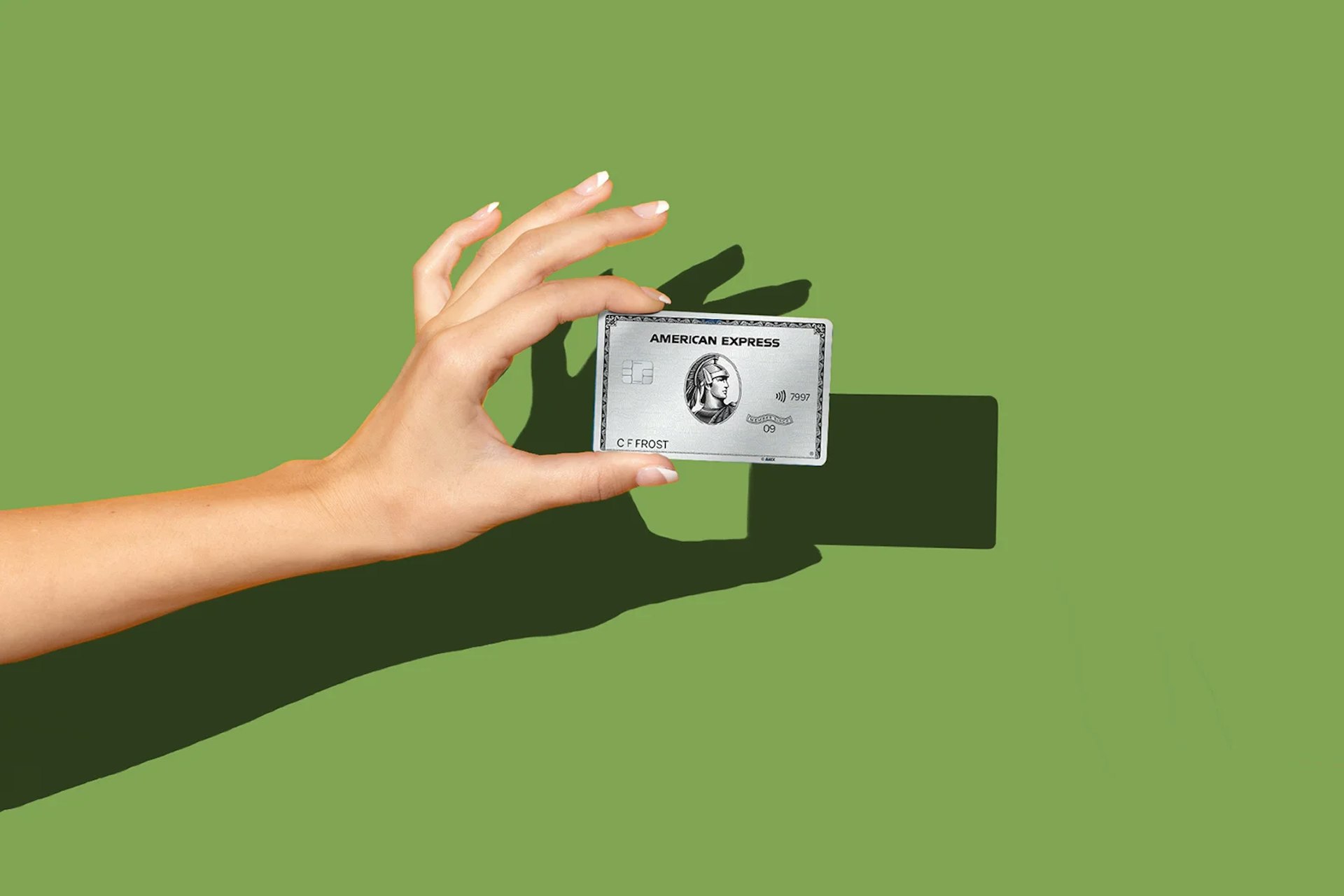
Overview of The Platinum Card® from American Express
Between the robust portfolio of perks, statement credits and travel insurance benefits* and the wide range of redemption options you’ll have when it’s time to exchange your Membership Rewards points, it’s no wonder The Platinum Card is one of the most sought-after travel cards on the market.
Designed with luxury-loving travelers in mind, the card provides access to over 1,400 airport lounges worldwide and an array of credits toward everything from CLEAR Plus membership to a Walmart+ subscription and a generous welcome bonus to get your points-earning journey started right.
While points-earning opportunities are most lucrative when booking flights and hotels via AmexTravel.com (5X points), you’ll still earn 5X points when purchasing flights through the airline for up to $500,000 of these purchases per calendar year and 1X points for all other spending.
As for redeeming points, you can transfer them to any of Amex’s 21 airline and hotel partners, book travel elements through AmexTravel.com, exchange them for gift cards or use them to pay for recent charges or merchandise.
The best travel credit cards
The pros and cons of the Amex Platinum Card®
- Lucrative welcome bonus: The 80,000 bonus points you’ll earn after spending $8,000 within the first six months of account opening are worth $1,600 in travel when redeemed through Membership Rewards.
- 21 travel transfer partners: There are 18 airlines and three hotel brands to choose from if you want to maximize your redemption by transferring your points to a travel partner.
- Lounge access: Cardholders receive access to over 1,400 lounges worldwide through The American Express Global Lounge Collection and its Priority Pass and Plaza Premium Lounge partners.
How to make a travel budget using points and miles
- High annual fee: It’s $695 (see rates and fees ), but that annual fee will pay for itself quickly if you maximize all the included credits, which are worth up to $1,584 in value.
- Limited earning categories: With this card, you’ll earn 5X points by booking flights directly with the airline or by reserving flights and hotels via AmexTravel.com, but just 1X points for all other purchases.
- Lots of travel-related perks: If you aren’t traveling for a while, this card might not be worth it since so many of its benefits are related to flights, hotels, lounges and credits for CLEAR Plus membership.
Best travel credit cards for hotels

The Platinum Card® from American Express benefits
The Amex Platinum is a premium rewards-earning credit card designed for those who prefer to relax in the lounge and enjoy the finer things while traveling. Here’s what makes it one of the best.
Best credit cards for international travel
Welcome bonus
New applicants can pick up 80,000 bonus points once they spend $8,000 within the first six months of account opening. While that’s worth $1,600 in travel when they’re redeemed through Amex Membership Rewards, you’ll get a better value by transferring points to one of Amex’s 21 travel partners.
Should you book travel with cash or points?

Earning rewards
Cardholders can earn 5X points by booking flights directly with the airline or through AmexTravel.com (up to $500,000 per year) or by reserving prepaid hotels — including The Hotel Collection properties, which have their own perks, like up to a $100 hotel credit, room upgrades and complimentary breakfast — through AmexTravel.com. Otherwise, you’ll pick up just 1X points for all other purchases.
In other words, if you’re a fan of AmexTravel.com, you’ll make out like a bandit. But unlike other travel credit cards , you won’t have the opportunity to earn bonus points for everyday purchases like groceries and dining or travel bookings made outside the Amex Membership Rewards portal.
How to use points and miles to save money on travel

Travel perks
This card provides no shortage of premium travel benefits, including a $200 credit for Fine Hotels + Resorts and The Hotel Collection stays reserved via AmexTravel.com and a $200 airline fee credit toward incidentals on a designated airline.
Cardmembers also receive up to a $189 credit toward CLEAR Plus membership, statement credits to cover your Global Entry or TSA PreCheck enrollment, automatic Hilton Honors Gold and Marriott Bonvoy Gold Elite status and complimentary access to over 1,400 lounges worldwide through The American Express Global Lounge Collection and its Priority Pass and Plaza Premium Lounge partners.
The card comes with baggage insurance, trip interruption and cancellation insurance, trip delay reimbursement, secondary coverage for standard car rentals, evacuation and medical transportation in an emergency and access to a global emergency assistance hotline, just in case.*
You’ll also have access to a network of travel counselors to help you plan out your trip and take care of any issues that may arise. And you’ll never have to worry about paying foreign transaction fees for using the card abroad .
Best travel credit cards for foodies
Other benefits
Besides all the trip-related benefits listed above, the Amex Platinum throws in some great perks to use even if you’re not traveling.
For starters, you’ll receive an annual credit of up to $155 ($12.95 plus tax per month) for a Walmart+ membership, up to $300 in statement credits annually for an Equinox gym membership and $100 worth of credits ($50 per six-month period) for Saks Fifth Avenue purchases.
Enjoy Uber VIP status and up to $200 in Uber savings on rides or eats orders in the US annually. Uber Cash and Uber VIP status is available to Basic Card Member only. Terms Apply.
$240 Digital Entertainment Credit: Get up to $20 back in statement credits each month on eligible purchases made with your Platinum Card® on one or more of the following: Disney+, a Disney Bundle, ESPN+, Hulu, The New York Times, Peacock, and The Wall Street Journal. Enrollment required.
Additionally, the card offers extended warranty protection (up to one year) as well as purchase protection and return protection (each up to 90 days) and cell phone protection up to $800 per claim (two claims allowed every 12 months, with a $50 deductible)*. You’ll also get exclusive access to dining, cultural, musical and sporting events through American Express.
The best credit cards with no international fees
Redeeming points
Cardholders have a ton of options when it’s time to redeem Membership Rewards points, though their value ranges between 0.6 cents per point and 1 cent per point, depending on how you do it.
If you won’t be traveling anytime soon, redeem points for gift cards or use them to cover eligible charges or to pay for purchases when shopping online through MembershipRewards.com, Amazon, PayPal, Best Buy, GrubHub, Seamless or Staples, among others.
Get into the habit of checking your account (via the website or app) to see if there are Amex Offers, which you can activate for your card and use to earn even more points with every purchase.
Here’s a look at the most lucrative ways to redeem your Amex MR points:
Best credit cards for road trips

Transferring to American Express travel partners
You’ll have 21 travel transfer partners to choose from — 18 airline and three hotel loyalty programs — to get the biggest bang for your buck when redeeming your points. Check the website regularly to see if there are transfer bonuses, which would provide even more value.
Here’s a full list of American Express Membership Rewards travel partners, which each offer redemptions at a transfer ratio of 1:1 except where noted:
- Aer Lingus AerClub
- AeroMexico Rewards (1:1.6)
- Air Canada Aeroplan
- Air France/KLM Flying Blue
- ANA Mileage Club
- Avianca LifeMiles
- British Airways Executive Club
- Cathay Pacific Asia Miles
- Delta Air Lines SkyMiles
- Emirates Skywards
- Etihad Guest
- Hawaiian Airlines HawaiianMiles
- Iberia Plus
- JetBlue TrueBlue (1:0.8)
- Qantas Frequent Flyer
- Qatar Airways Privilege Club
- Singapore Airlines KrisFlyer
- Virgin Atlantic Flying Club
- Choice Privileges
- Hilton Honors (1:2)
- Marriott Bonvoy
Keep in mind that those loyalty programs are also a gateway to each airline’s alliance partners via Star Alliance, Oneworld or SkyTeam, so you could end up scoring an even better deal by taking advantage of those partnerships.
For example, you could transfer Amex MR points to Avianca LifeMiles and then use those miles to save on flights to New Zealand via United Airlines or Air New Zealand. Or, you could transfer Amex MR points to ANA Mileage Club and then use those miles to fly to Australia via United Airlines or Air Canada.
10 amazing hotels around the world you can book with points
American Express Membership Rewards travel portal
You’ll generally find that redemptions within the American Express Membership Rewards travel portal yield a value of about 1 cent per point, making them slightly less valuable than an outright transfer to a partner but still worth more than if you redeemed them for gift cards or merchandise.
That said, if you’re just starting out with points and miles and aren’t yet ready to deal with transferring points to partner loyalty programs, making a no-nonsense redemption directly through the portal is an easy option.
The best credit cards for airline miles
How The Amex Platinum compares to other cards
While the Amex Platinum is a fantastic travel rewards credit card, others offer similar premium perks — and for a lower annual fee.
Deciding which card works best for you depends on a number of factors, including your personal travel preferences, the amount of perks, points-earning opportunities and redemption options offered, and whether or not you’d rather transfer your points to loyalty program partners or book flights and hotels directly through the credit card’s travel portal.
Here’s how the Amex Platinum holds up against similar travel credit cards:
Traveling to Japan using points and miles
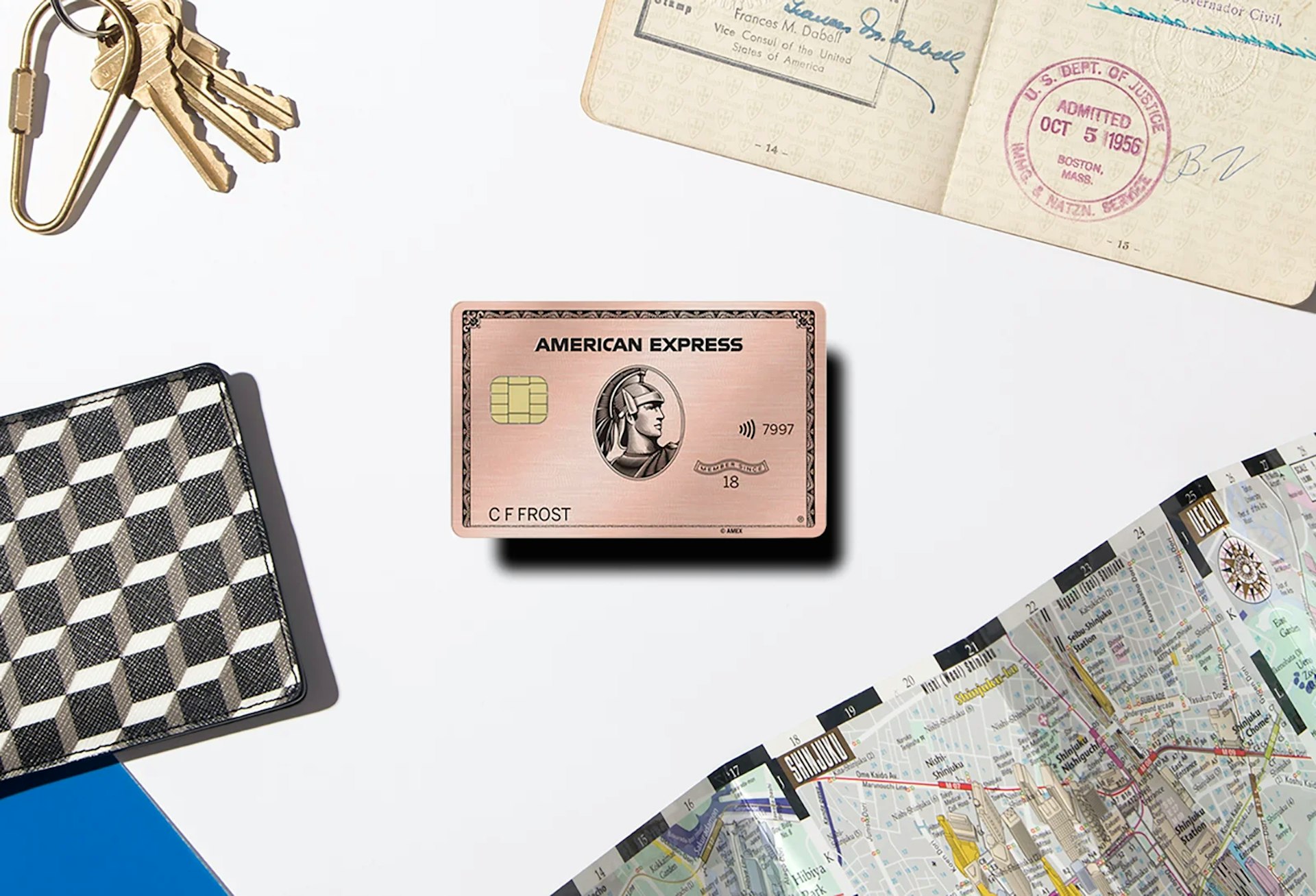
Amex Platinum vs. American Express® Gold Card
While you’ll have some of the same features as the Amex Platinum Card — redemption options, transfer partners and access to The Hotel Collection and exclusive event seating — the American Express® Gold Card * gives you more chances to earn points on everyday purchases, has a lower annual fee of $250 (see rates and fees ) and includes dining credits to use whether or not you’re traveling.
Its welcome bonus is lower (60,000 bonus points after spending $6,000 within the first six months of account opening), but with the Amex Gold Card, you’ll earn 4X points at restaurants worldwide and supermarkets in the US (up to $25,000, then 1X points), 3X points on flights booked directly with the airline or via AmexTravel.com and 1X points for all other purchases.
As far as statement credits, The Amex Gold Card provides up to a $120 dining credit ($10 per month) for GrubHub, Goldbelly, Wine.com, Milk Bar, The Cheesecake Factory and Shake Shack purchases, plus up to $120 in Uber cash ($10 per month) to use for rides or food delivery via Uber Eats.
It really comes down to your travel preferences, as the Amex Gold Card offers no lounge access. But if you’re not traveling for a while, it’s a great option for racking up MR points for future trips.
How to get major perks at global events and concerts with your credit card
Amex Platinum vs. Chase Sapphire Reserve®
With a $550 annual fee, similar lounge perks and a hefty welcome bonus (Earn 60,000 bonus points after you spend $4,000 on purchases in the first 3 months from account opening. That's $900 toward travel when you redeem through Chase Travel℠), the Chase Sapphire Reserve is a worthy contender.
It’s greatest assets: a $300 annual travel credit, a $100 credit toward Global Entry or TSA PreCheck enrollment, more points-earning opportunities than the Amex Platinum Card and primary rental car insurance (whereas Amex only offers secondary coverage). Plus, your rewards are worth 1.5 cents per point when redeemed through Chase Travel℠.
The Chase Sapphire Reserve also offers limited-time benefits like two free years of Lyft Pink membership, one complimentary year of DoorDash/Caviar, $5 monthly DoorDash credits, a free year of Instacart and $15 monthly Instacart credits.
Earn 5x total points on flights and 10x total points on hotels and car rentals when you purchase travel through Chase Travel℠ immediately after the first $300 is spent on travel purchases annually. Earn 3x points on other travel and dining & 1 point per $1 spent on all other purchases.
If you prefer to redeem points with one of Chase’s 14 transfer partners, need a lower annual fee and plan to use all the Instacart and Lyft credits, the Chase Sapphire Reserve could be a better pick over the Amex Platinum.
10 amazing US hotels you can book with points

Amex Platinum vs. Capital One Venture X Rewards Credit Card
The Capital One Venture X Rewards Credit Card is another worthy opponent, with a lower annual fee of $395 (see rates and fee ), a generous welcome bonus (75,000 bonus miles after spending $4,000 within the first three months of account opening) and similar premium perks.
Like the other cards, you’ll get a $100 statement credit for Global Entry or TSA PreCheck enrollment and access to exclusive cardholder dining and entertainment events. You can also book luxury accommodations via Capital One’s Premier and Lifestyle Collections, each offering its own perks.
Unlike the others, the Capital One Venture X card rewards members with 10,000 bonus miles to celebrate their anniversary. You’ll also get automatic Hertz President’s Circle elite status, primary car insurance for rentals and access to over 1,300 lounges worldwide, including Capital One Lounges and their Priority Pass and Plaza Premium Lounge partner sites.
There aren’t many downsides to this card besides its limitations. While the Chase Sapphire Reserve’s $300 annual travel credit covers all travel purchases, the $300 annual travel credit offered by Capital One Venture X can only be used toward bookings made via Capital One Travel.
While the highest-earning opportunities are limited to Capital One’s ecosystem — 10X miles for hotel and rental cars and 5X for flights booked via Capital One Travel — you’ll earn 2X miles for all other purchases. The card also has cell phone protection and lets you transfer Capital One miles to any of its 18 airline and hotel partners.
So, if you prefer Capital One Travel and its partners over Amex Membership Rewards and its partners but want to enjoy similar perks for a lower annual fee, Venture X could be a better pick.
The best credit cards for Global Entry
Is the Amex Platinum Card worth getting?
For those who prefer luxury travel, The Amex Platinum makes a great choice thanks to the premium level of perks it provides. From lounge access to extra perks and instant elite status at Hilton and Marriott hotels, there’s a reason this card is constantly topping travel rewards card lists.
Besides the generous welcome bonus, new applicants won’t have to worry about foreign transaction fees or dealing with Chase’s pesky 5/24 rule (which means your application won’t be accepted as long as you’ve already applied for five credit cards within 24 months).
If, however, your credit card strategy involves adding more Chase cards (like the Chase Sapphire Preferred® Card or Chase Sapphire Reserve ), you may want to hold off on this one until you’ve gotten those since adding the Amex Platinum Card would contribute to your list of five new cards in Chase’s eyes.
In general, the Amex Platinum Card is worth signing up for if you plan to maximize all the statement credits, if you prefer to book flights and hotels through AmexTravel.com (or flights directly with the airline) or if you prefer to transfer your points to one of its 21 travel partners.
Best credit cards for adventure travel

Is The Amex Platinum still a good credit card?
If you love airport lounges and swanky hotels, The Amex Platinum is an excellent choice. It all comes down to your travel style and whether or not you can use all the card’s benefits. If you don’t plan on traveling or maximizing the included statement credits, a different travel credit card might be a better option.
American Express Gold Card® review
What lounges can you get into with the Amex Platinum?
You’ll have access to over 1,400 lounges worldwide, including American Express Centurion® Lounges and Escape Lounges (The Centurion® Studio Partner), Plaza Premium Lounges, Delta Sky Club lounges (limited to 10 days per year as of Feb. 1, 2025), Priority Pass Select lounges, Lufthansa lounges and other Global Lounge Collection partners.
American Express Membership Rewards vs. Chase Ultimate Rewards
How much are American Express Membership Rewards points worth?
Cardholders will get the most value by transferring points to an airline or hotel partner. Membership Rewards points are worth up to 1 cent per point when redeemed for gift cards or 0.6 cents per point when exchanged for statement credits. They’re also worth anywhere from 0.7 to 1 cent per point when used to pay for online purchases or up to 1 cent per point when you use the Pay with Points feature through American Express Travel.
Best credit cards for traveling with kids
Is it hard to qualify for The Platinum Card® from American Express?
You’ll need a good to excellent credit score (670 to 850) to be accepted. Additional factors like your debt-to-income ratio, credit history and current income also come into consideration to determine your creditworthiness. Check your credit report for free on AnnualCreditReport.com to see where you stand with the main credit bureaus (Experian, TransUnion and Equifax).
Traveling to Europe using points and miles
* Eligibility and Benefit level varies by Card. Terms, Conditions, and Limitations Apply. Please visit americanexpress.com/ benefitsguide for more details. Underwritten by Amex Assurance Company.
Terms apply to American Express benefits and offers. Enrollment may be required for select American Express benefits and offers. Visit americanexpress.com to learn more.
Editorial disclaimer: Opinions expressed here are the author’s alone, not those of any bank, credit card issuer, airline or hotel chain, and have not been reviewed, approved or otherwise endorsed by any of these entities.
This article was first published December 2023 and updated March 2024
Explore related stories

Destination Practicalities
Apr 26, 2024 • 6 min read
Plan your visit to Saskatoon, the largest city in the Canadian province of Saskatchewan, with our first-timer's guide.

Apr 26, 2024 • 7 min read

Apr 25, 2024 • 9 min read

Apr 25, 2024 • 7 min read

Apr 25, 2024 • 6 min read

Apr 25, 2024 • 5 min read

- Credit cards
- View all credit cards
- Banking guide
- Loans guide
- Insurance guide
- Personal finance
- View all personal finance
- Small business
- Small business guide
- View all taxes
You’re our first priority. Every time.
We believe everyone should be able to make financial decisions with confidence. And while our site doesn’t feature every company or financial product available on the market, we’re proud that the guidance we offer, the information we provide and the tools we create are objective, independent, straightforward — and free.
So how do we make money? Our partners compensate us. This may influence which products we review and write about (and where those products appear on the site), but it in no way affects our recommendations or advice, which are grounded in thousands of hours of research. Our partners cannot pay us to guarantee favorable reviews of their products or services. Here is a list of our partners .
What’s the Value of AmEx Membership Rewards Points?

Many or all of the products featured here are from our partners who compensate us. This influences which products we write about and where and how the product appears on a page. However, this does not influence our evaluations. Our opinions are our own. Here is a list of our partners and here's how we make money .
Table of Contents
When booking travel through the portal
When transferring to partners, amex points calculator: convert points to dollars, cards that earn amex points, how did we determine our amex points value, amex points value recapped.
American Express Membership Points are worth 1 cent each on FHR & flights booked in the portal. Other in-portal direct redemptions are worth 0.7 cents.
The current AmEx points value is 2.8 cents when transferred to partners.
AmEx has 20 airline and hotel partners.
Flexible travel rewards like American Express Membership Rewards points are, effectively, a currency. So understanding the relative value of these points is an important consideration when earning or spending them.
So how much are AmEx points worth? Based on NerdWallet's most recent analysis , the current AmEx points value is between 1 cent when used to book travel directly and 2.8 cents when transferred to partners.
This is a big gap, and you might wonder why anyone would use these points to book travel directly if they’re so much more valuable when transferred. The short explanation is based on convenience — booking through the AmEx travel portal is a snap, whereas transferring and redeeming points can be significantly more labor intensive.
» Learn more: Best American Express credit cards
This is simple: American Express Membership Points are worth exactly 1 cent apiece when booking flights or 0.7 cent if booking hotels through the issuer's portal. This math is made explicit when booking a flight or hotel while logged in.

For example, a $210 flight will cost 21,000 points. There’s no way to “maximize” AmEx points when used in this way. You’re effectively using the points as pennies, and can book any airline or hotel room available with cash.
» Learn more: Comparing AmEx points vs. Chase Ultimate Rewards®
The big benefit here is convenience and simplicity. You don’t have to spend hours researching how to use your points or find the right transfer partner, or search for scarce award availability. You just search and book.
The big drawback is cost-effectiveness. You’re accepting a lowball value for your points as a trade-off for this convenience.

Here’s where things get more interesting — and complicated. The AmEx Membership Rewards program has some excellent transfer partners, meaning you can transfer your points to a partner and then book travel there.
AmEx has 20 airline and hotel partners, compared to Chase's 14 transfer partners . That means more access to airline sweet spots for AmEx points collectors.
With great maximization potential comes great responsibility. Understanding which AmEx transfer partners offer the best value, and which even offer flights or hotels that match your travel plans, is a major undertaking.
Here are some key programs to highlight, along with their estimated NerdWallet value.
Notice that some of the better-known programs, such as Marriott and British Airways, offer some of the lowest-value points and miles, while lesser-known programs, like Air Canada and ANA, offer some of the best.
It definitely pays to do your homework when considering AmEx transfer partnerships.
Remember to factor your travel plans into consideration, and not just transfer your points to the program with the highest-value miles. Some programs offer excellent value but limited routes and award availability.
Always search for availability on your preferred travel dates and destinations before transferring points.
» Learn more: The best first class award flights you can actually book
Use our AmEx points calculator below to convert AmEx points to dollars and determine the value of your stash of points, based on both the baseline and NerdWallet estimated values.
Another resource to help you get the best value for AmEx points is our Airline Point Transfers and Partner Award Bookings tool .
» Learn more: The best online travel booking portal might surprise you
More than a dozen American Express cards earn Membership Rewards; here are some of the most popular, including some with no annual fee :
American Express® Gold Card
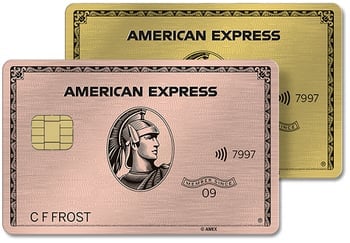
Earn 4 Membership Rewards points per dollar spent at restaurants.
Earn 4 points per dollar spent at U.S. supermarkets (on up to $25,000 in spending each year, then 1 point back).
Earn 3 points per dollar spent on flights booked directly with airlines and American Express Travel.
Earn 1 point per dollar spent on all other eligible purchases.
The current welcome offer is: Earn 60,000 Membership Rewards® points after you spend $6,000 on eligible purchases with your new Card within the first 6 months of Card Membership. Terms Apply.
The Platinum Card® from American Express
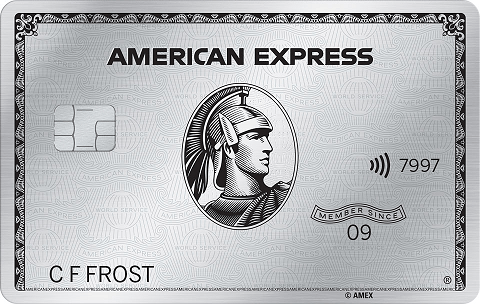
Earn 5 Membership Rewards points on flights booked directly with airlines or with American Express Travel.
Earn 5 points on prepaid hotels booked on American Express Travel.
Earn 1 point on all other eligible purchases.
New members are enticed with this welcome offer: Earn 80,000 Membership Rewards® Points after you spend $8,000 on purchases on your new Card in your first 6 months of Card Membership. Terms Apply.
American Express® Business Gold Card
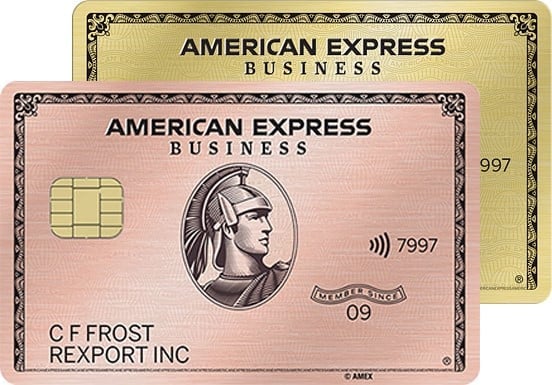
Earn 4x Membership Rewards points per dollar spent in two categories (from the following six) where you spend the most each billing cycle (up to the first $150,000 in combined purchases per year; then 1 point back):
Airfare purchased directly from airlines.
U.S. purchases at restaurants.
U.S. purchases at gas stations.
U.S. purchases for shipping.
U.S. purchases for advertising in select media (online, TV, radio).
U.S. purchases made directly from select technology providers of computer hardware, software and cloud solutions.
Other spending earns 1x point per dollar spent. Terms apply.
The Business Platinum Card® from American Express
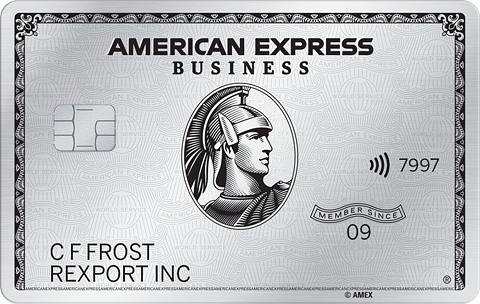
Earn 5 Membership Rewards points per dollar spent on eligible flights and prepaid hotels booked through American Express — and earn 1 point for each dollar you spend on eligible purchases.
Earn 1.5 points per dollar on eligible purchases at U.S. construction material and hardware suppliers, electronic goods retailers, software and cloud system providers and shipping providers — as well as on purchases of $5,000 or more everywhere else, on up to $2 million of these purchases per calendar year.
Terms apply.
Other AmEx cards that earn Membership Rewards points include:
The Blue Business® Plus Credit Card from American Express .
Business Green Rewards Card from American Express .
The Amex EveryDay® Preferred Credit Card from American Express .
Amex EveryDay® Credit Card .
American Express® Green Card .
» Learn more: The best travel credit cards
For our NerdWallet estimate of 2.8 cents per Membership Rewards point, we factored in several variables:
The value of these points when used to book travel directly with the credit card’s travel portal.
The value of the airline and hotel points to which these points can be transferred, when applicable (based on the separate analyses above).
The number of top-tier travel transfer partners, as determined by our expert panel.
The overall value is determined as: A weighted average between (1) and (2), with the weight determined by (3). The program with the largest number of high-value partners receives a 100% weight on (2), and a program with zero high-value partners receives a 50% weight on (2).
AmEx had the highest number of top-tier transfer partners, so it received a 100% weight on its most valuable transfer partner (ANA).

The current AmEx points value is between 1 cent when used to book travel directly and 2.8 cents when transferred to partners.
But not all transfer partners are created equal. Popular programs like Marriott Bonvoy will net you less value than lesser-known options, such as ANA.
If maximizing AmEx points' value sounds too complicated, you can always redeem them for a statement credit through the issuer's Cover Your Card Charges benefit. This will get you a paltry rate of just 0.6 cent per point.
To view rates and fees of the American Express® Gold Card , see this page . To view rates and fees of The Platinum Card® from American Express , see this page . To view rates and fees of the American Express® Business Gold Card , see this page . To view rates and fees of The Business Platinum Card® from American Express , see this page .
How to maximize your rewards
You want a travel credit card that prioritizes what’s important to you. Here are our picks for the best travel credit cards of 2024 , including those best for:
Flexibility, point transfers and a large bonus: Chase Sapphire Preferred® Card
No annual fee: Bank of America® Travel Rewards credit card
Flat-rate travel rewards: Capital One Venture Rewards Credit Card
Bonus travel rewards and high-end perks: Chase Sapphire Reserve®
Luxury perks: The Platinum Card® from American Express
Business travelers: Ink Business Preferred® Credit Card
On a similar note...

You are using an outdated browser. Please upgrade your browser to improve your experience.
Card Accounts
Business Accounts
Other Accounts and Payments
Tools and Support
Personal Cards
Business Credit Cards
Corporate Programs
Prepaid Cards
Personal Savings
Personal Checking and Loans
Business Banking
Book And Manage Travel
Travel Inspiration
Business Travel
Services and Support
Benefits and Offers
Manage Membership
Business Services
Checking & Payment Products
Funding Products
Merchant Services
How to use Pay with Points
Use Membership Rewards ® points for all or part of your flight, prepaid hotel, prepaid car rental, vacation packages (flight and prepaid hotel), or prepaid cruise when you book through American Express Travel ® .*
Just follow these easy steps
Search
Log in to AmexTravel.com to access Membership Rewards points and begin by searching for a trip as usual.
Apply Points
At checkout, select either "Use Only Points" or "Use Points + Card" then apply points to your booking.
Book Trip
Once booked, your Card will be charged the full dollar amount. A corresponding credit for the value of points used will be applied to your account in a separate transaction within 48 hours .
See where points can take you
More about American Express Membership Rewards points
When you use Pay with Points, the full dollar amount will be charged to your American Express ® Card and a corresponding credit for the value of points used will be applied to your account in a separate transaction within 48 hours.
To use Pay with Points, you must use a Membership Rewards ® program enrolled Card for payment. Plan It ® cannot be combined with Pay with Points.
If you cancel your booking, you will receive a statement credit on your Card account. To have the Membership Rewards points returned to your account, you can contact us at 1-800-AXP-EARN (297-3276).
Delta Skymiles ® cannot be redeemed at AmexTravel.com.
How to earn points
When you use your eligible American Express Card to make purchases, you'll earn Membership Rewards points for every dollar you spend on qualifying purchases.
Why book with American Express Travel?
Use Pay with Points for your next Hotel Stay
Have a question?
What are membership rewards points worth.
You can use the Points Value Calculator to see what Membership Rewards points are worth and how you can use them.
Can I combine points and my Card to pay?
Yes, at checkout, select "Use Points + American Express Card" then apply points to your booking. You still need a minimum of 5,000 points to apply points.
Why was my American Express Card charged for my trip when I selected the Pay with Points option?
When you use Pay with Points, the full dollar amount will be charged to your American Express Card and a corresponding credit for the value of points used will be applied to your account in a separate transaction within 48 hours.
Can I cancel a trip that I booked using Membership Rewards points?
Yes. If you cancel your booking, you will receive a statement credit on your Card account. To have the Membership Rewards points returned to your account, you can contact us at 1-800-AXP-EARN (297-3276).
Can I use Pay with Points for a car rental?
Yes, you can use Pay with Points for prepaid car rentals. For reservations that require payment at time of pick-up, payment is handled directly with the vendor.
Can I use Pay with Points for a hotel reservation?
Yes, you can use Pay with Points for prepaid hotel reservations. For hotel reservations that require payment at time of check-out, payment is handled directly with the property.
Can I transfer Membership Rewards points to a Frequent Flyer program?
Yes, you can transfer Membership Rewards points to participating partners in three steps:
- Link your account
- Select amount to transfer
- Redeem with selected provider
Frequent traveler program airlines determine how many points, miles or other units are required to get rewards in their frequent traveler programs. This applies to select airlines, and value of points varies by airline, flight, class of ticket (ie: upgrades), and date of travel. Additional domestic or international airline fees may apply.
Get Started
Note: For point transfers to airlines, we recommend making the reservations first and verifying any blackout dates that may apply.
Can I transfer Frequent Flyer miles to Membership Rewards points?
No, you cannot transfer Frequent Flyer miles to Membership Rewards points, however you can transfer your Membership Rewards points to a Frequent Flyer program.
Can I transfer points to a Hotel Frequent Guest Program?
Note: Frequent guest program properties determine how many points, or other units are required to get rewards in their frequent guest programs for hotel stays. This applies to select properties, and value of points can vary depending on hotel room type.
Will I earn Frequent Guest Points with my hotel if I use points for my booking?
It depends on the type of booking you choose on your reservation type. Visit My Trips to determine if your hotel booking type is eligible to earn points.
Will I earn Membership Rewards points if I use points for my booking?
Any portion of a charge that you elect to cover through redemption of Membership Rewards points is not eligible to earn points. If you checkout using a combination of points and your Card, you will earn points on the portion paid for with your Card.
Need Assistance? Give us a call. Our travel counselors are here to help.
Call the number on the back of your Card.

*Terms & Conditions
Membership Rewards® Pay with Points
To use Pay with Points, you must charge your eligible purchase through American Express Travel to a Membership Rewards® program-enrolled American Express® Card. Eligible purchases through American Express Travel exclude non-prepaid car rentals and non-prepaid hotels. Points will be debited from your Membership Rewards account, and credit for corresponding dollar amount will be issued to the American Express Card account used. If points redeemed do not cover entire amount, the balance of purchase price will remain on the American Express Card account. Minimum redemption 5,000 points.
See membershiprewards.com/terms for the Membership Rewards program terms and conditions.
If a charge for a purchase is included in a Pay Over Time balance on your Linked Account the statement credit associated with that charge may not be applied to that Pay Over Time balance. Instead the statement credit may be applied to your Pay in Full balance. If you believe this has occurred, please contact us by calling the number on the back of your Card. Corporate Card Members are not eligible for Pay Over Time.
Membership Rewards® Program
Terms and Conditions for the Membership Rewards® program apply. Visit membershiprewards.com/terms for more information. Participating partners and available rewards are subject to change without notice.
The value of Membership Rewards points varies according to how you choose to use them. To learn more, go to www.membershiprewards.com/pointsinfo.
Seller of Travel
American Express Travel Related Services Company, Inc. is acting solely as a sales agent for travel suppliers and is not responsible for the actions or inactions of such suppliers. Certain suppliers pay us commission and other incentives for reaching sales targets or other goals and may provide incentives to our Travel Consultants. For more information visit www.americanexpress.com/travelterms.
California CST#1022318; Washington UBI#600-469-694
Advertiser Disclosure
Many of the credit card offers that appear on this site are from credit card companies from which we receive financial compensation. This compensation may impact how and where products appear on this site (including, for example, the order in which they appear). However, the credit card information that we publish has been written and evaluated by experts who know these products inside out. We only recommend products we either use ourselves or endorse. This site does not include all credit card companies or all available credit card offers that are on the market. See our advertising policy here where we list advertisers that we work with, and how we make money. You can also review our credit card rating methodology .
- Credit Cards
Amex Membership Rewards Transfer Partners & How To Use Them [2024]
Jarrod West
Senior Content Contributor
439 Published Articles 1 Edited Article
Countries Visited: 21 U.S. States Visited: 24
Keri Stooksbury
Editor-in-Chief
32 Published Articles 3130 Edited Articles
Countries Visited: 47 U.S. States Visited: 28
![points guy amex travel Amex Membership Rewards Transfer Partners & How To Use Them [2024]](https://upgradedpoints.com/wp-content/uploads/2019/10/Lufthansa_B748_First_Class_Seat_1A_Cherag_Dubash.jpg?auto=webp&disable=upscale&width=1200)
Amex Airline Transfer Partners
Amex hotel transfer partners, how to transfer membership rewards, american express transfer bonuses, earning amex membership rewards, should you transfer or book through amex, other ways to use your points, combining membership rewards from different accounts, redeeming membership rewards, final thoughts.
We may be compensated when you click on product links, such as credit cards, from one or more of our advertising partners. Terms apply to the offers below. See our Advertising Policy for more about our partners, how we make money, and our rating methodology. Opinions and recommendations are ours alone.
If you’re looking for a way to earn lots of points to redeem for some amazing travel, you can’t go wrong with American Express Membership Rewards credit cards. Amex provides a number of ways to earn Membership Rewards points and plenty of fun ways to redeem them for some great flights.
In this post, we’ll show you all of the American Express transfer partners, how to transfer Membership Rewards to these partners, and much more. With this guide in hand, you’ll be ready to book some amazing vacations!
The American Express Membership Rewards program has a ton of airline transfer partners.
Make sure you check the transfer rate (see below) since not all transfers are done at a 1:1 ratio.
Membership Rewards can also be transferred to 3 hotel rewards programs.
Like American Express airline partners, transfer ratios vary (see below), so make sure you check them before transferring.
Hot Tip: Use our transfer partner tool to see how many points you’ll get when you transfer your Amex Membership Rewards to their partner airlines and hotels!
With some Membership Rewards points in your account , it’s time to decide where you want to transfer your points so you can start traveling. Here are the simple steps to make the transfer process easy.
Step 1: Select Earn and Redeem from the menu.
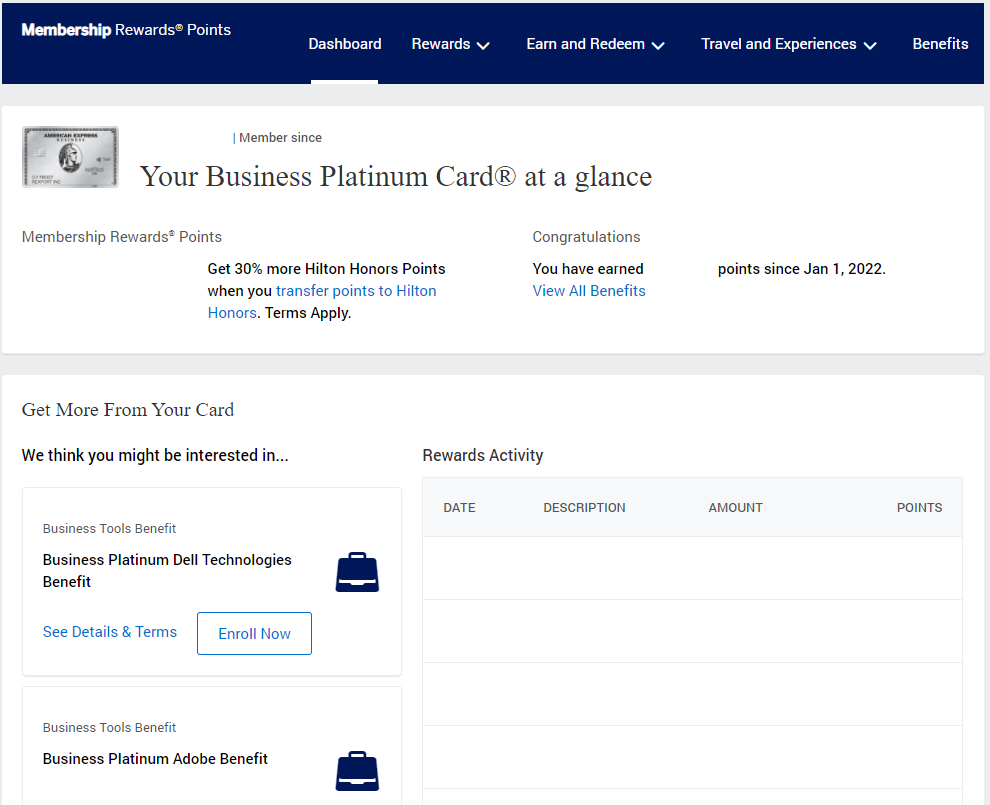
Step 2: Select Transfer Points under Redeem .

Step 3: Choose your desired airline or hotel transfer partner and select Transfer Points . If you haven’t already, you will need to link your frequent flyer account to your Membership Rewards account. In the example below, we chose Delta Air Lines.

Step 4: Once you have linked your airline or hotel account to your Membership Rewards account, choose how many points you would like to transfer. Transfers must be made in increments of 1,000.
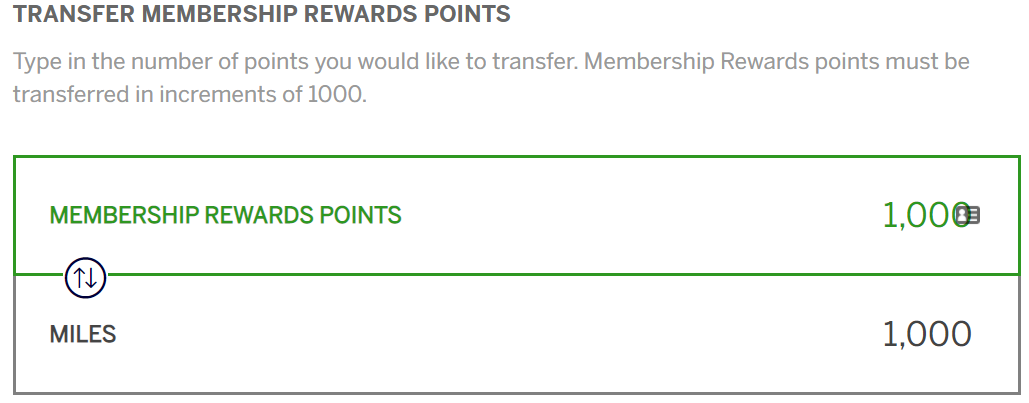
Step 5: Confirm the number of points you are transferring and complete the transfer.

Step 6: Head over to the appropriate airline or hotel program to book your award flight or award stay.
Bottom Line: Transferring Amex points to partners is easy. Just have your loyalty program numbers handy and your Amex card details, and you’ll be good to go!
Transferring your points when there is a bonus is an ideal situation. Getting the most value out of every point you have is the key to getting those high-level redemptions!
Amex has previously offered both public and targeted transfer bonus offers of 15% to 40%. For example, if you were to transfer 10,000 points when a particular partner is offering a 40% bonus offer, your points would be worth 14,000 points after transfer.
However, you shouldn’t transfer points JUST because there is a bonus. It’s best to keep your points in a transferable account (like Amex, Capital One, Chase, Citi, or Marriott Bonvoy) until you have a specific redemption in mind.
American Express provides tons of opportunities to earn Membership Rewards points . Pick the card or combination of cards that will help you earn the most points and get the benefits that matter to you.
Recommended American Express Cards (Personal)
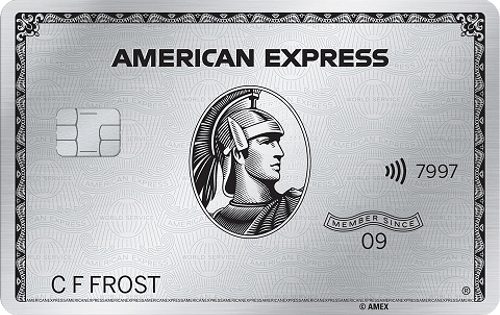
The Platinum Card ® from American Express
The Amex Platinum reigns supreme for luxury travel, offering the best airport lounge access plus generous statement credits, and complimentary elite status.
When it comes to cards that offer top-notch benefits, you’d be hard-pressed to find a better card out there than The Platinum Card ® from American Express.
Make no mistake — the Amex Platinum card is a premium card with a premium price tag. With amazing benefits like best-in-class airport lounge access , hotel elite status, and tremendous value in annual statement credits, it can easily prove to be one of the most lucrative cards in your wallet year after year.
- The best airport lounge access out of any card (by far) — enjoy access to over 1,400 worldwide lounges, including the luxurious Amex Centurion Lounges, Priority Pass lounges, Plaza Premium Lounges, and many more!
- 5x points per dollar spent on flights purchased directly with the airline or with AmexTravel.com (up to $500,000 per year)
- 5x points per dollar spent on prepaid hotels booked with AmexTravel.com
- Annual and monthly statement credits upon enrollment ( airline credit, Uber Cash credit, Saks Fifth Avenue credit, streaming credit, prepaid hotel credit on eligible stays, Walmart+ credit, CLEAR credit, and Equinox credit )
- TSA PreCheck or Global Entry credit
- Access to American Express Fine Hotels and Resorts
- Access to Amex International Airline Program
- No foreign transaction fees ( rates and fees )
- $695 annual fee ( rates and fees )
- Airline credit does not cover airfare (only incidentals like checked bags)
- Earn 80,000 Membership Rewards ® Points after you spend $8,000 on purchases on your new Card in your first 6 months of Card Membership. Apply and select your preferred metal Card design: classic Platinum Card ® , Platinum x Kehinde Wiley, or Platinum x Julie Mehretu.
- Earn 5X Membership Rewards ® Points for flights booked directly with airlines or with American Express Travel up to $500,000 on these purchases per calendar year and earn 5X Membership Rewards ® Points on prepaid hotels booked with American Express Travel.
- $200 Hotel Credit: Get up to $200 back in statement credits each year on prepaid Fine Hotels + Resorts ® or The Hotel Collection bookings with American Express Travel when you pay with your Platinum Card ® . The Hotel Collection requires a minimum two-night stay.
- $240 Digital Entertainment Credit: Get up to $20 back in statement credits each month on eligible purchases made with your Platinum Card ® on one or more of the following: Disney+, a Disney Bundle, ESPN+, Hulu, The New York Times, Peacock, and The Wall Street Journal. Enrollment required.
- $155 Walmart+ Credit: Cover the cost of a $12.95 monthly Walmart+ membership (subject to auto-renewal) with a statement credit after you pay for Walmart+ each month with your Platinum Card ® . Cost includes $12.95 plus applicable local sales tax. Plus Up Benefits are excluded.
- $200 Airline Fee Credit: Select one qualifying airline and then receive up to $200 in statement credits per calendar year when incidental fees are charged by the airline to your Platinum Card ® .
- $200 Uber Cash: Enjoy Uber VIP status and up to $200 in Uber savings on rides or eats orders in the US annually. Uber Cash and Uber VIP status is available to Basic Card Member only. Terms Apply.
- $300 Equinox Credit: Get up to $300 back in statement credits per calendar year on an Equinox membership, or an Equinox club membership (subject to auto-renewal) when you pay with your Platinum Card ® . Enrollment required. Visit https://platinum.equinox.com/ to enroll.
- $189 CLEAR ® Plus Credit: Breeze through security with CLEAR Plus at 100+ airports, stadiums, and entertainment venues nationwide and get up to $189 back per calendar year on your Membership (subject to auto-renewal) when you use your Platinum Card ® . Learn more.
- $100 Global Entry Credit: Receive either a $100 statement credit every 4 years for a Global Entry application fee or a statement credit up to $85 every 4.5 years for a TSA PreCheck ® (through a TSA official enrollment provider) application fee, when charged to your Platinum Card ® . Card Members approved for Global Entry will also receive access to TSA PreCheck at no additional cost.
- Shop Saks with Platinum: Get up to $100 in statement credits annually for purchases in Saks Fifth Avenue stores or at saks.com on your Platinum Card ® . That's up to $50 in statement credits semi-annually. Enrollment required.
- $300 SoulCycle At-Home Bike Credit: Get a $300 statement credit for the purchase of a SoulCycle at-home bike with your Platinum Card ® . An Equinox+ subscription is required to purchase a SoulCycle at-home bike and access SoulCycle content. Must charge full price of bike in one transaction. Shipping available in the contiguous U.S. only. Enrollment Required.
- Unlock access to exclusive reservations and special dining experiences with Global Dining Access by Resy when you add your Platinum Card ® to your Resy profile.
- $695 annual fee.
- Terms Apply.
Financial Snapshot
- APR: See Pay Over Time APR
- Foreign Transaction Fees: None
Card Categories
- Credit Card Reviews
- Travel Rewards Credit Cards
- Best Sign Up Bonuses
Rewards Center
American Express Membership Rewards
- Amex Platinum 150k Welcome Bonus Offer
- Benefits of The Amex Platinum
- How to Use 100,000 Amex Platinum Points
- Amex Platinum Card Requirements
- American Express Platinum Military Benefits
- Amex Platinum and Business Platinum Lounge Access
- Amex Platinum Benefits for Authorized Users
- Amex Platinum vs Delta Platinum
- Amex Platinum vs Chase Sapphire Reserve
- Capital One Venture X vs Amex Platinum
- Amex Platinum vs Delta Reserve
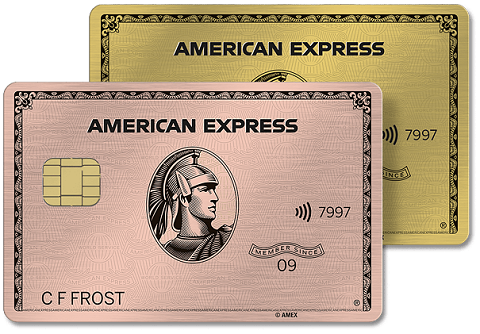
American Express ® Gold Card
This is the best card for food lovers who dine out at restaurants (worldwide), order take-out and want big rewards at U.S. supermarkets!
The American Express ® Gold Card is a game-changer.
With this card, you can earn 4x Membership Rewards points at restaurants and you’ll also earn 4x Membership Rewards points at U.S. supermarkets on up to $25,000 per calendar year in purchases, then 1x.
There isn’t another card on the market that offers a 1-2 punch like this. Of course, there are several other benefits of the Gold Card as well, including extra monthly dining rewards and more.
- 4x points per dollar at restaurants, plus takeout and delivery in the U.S.
- 4x points per dollar at U.S. supermarkets, up to $25,000 per calendar year in purchases; and 1x thereafter
- 3x points per dollar on flights purchased directly from airlines or at Amex Travel
- Up to $120 annual dining credit: up to $10 monthly statement credit when you pay with the Amex Gold card at Grubhub, The Cheesecake Factory, Goldbelly, Wine.com , Milk Bar and select Shake Shack locations
- Up to $120 in annual Uber Cash : get $10 monthly in Uber Cash for Uber Eats orders or Uber rides in the U.S. when you add your Gold Card to your Uber account
- No foreign transaction fees (see rates and fees )
- Access to Amex’s The Hotel Collection
- Access to American Express transfer partners
- $250 annual fee (see rates and fees )
- No lounge access
- Earn 60,000 Membership Rewards ® points after you spend $6,000 on eligible purchases with your new Card within the first 6 months of Card Membership.
- Earn 4X Membership Rewards ® Points at Restaurants, plus takeout and delivery in the U.S., and earn 4X Membership Rewards ® points at U.S. supermarkets (on up to $25,000 per calendar year in purchases, then 1X).
- Earn 3X Membership Rewards ® points on flights booked directly with airlines or on amextravel.com.
- $120 Uber Cash on Gold: Add your Gold Card to your Uber account and each month automatically get $10 in Uber Cash for Uber Eats orders or Uber rides in the U.S., totaling up to $120 per year.
- $120 Dining Credit: Satisfy your cravings and earn up to $10 in statement credits monthly when you pay with the American Express ® Gold Card at Grubhub, The Cheesecake Factory, Goldbelly, Wine.com, Milk Bar and select Shake Shack locations. Enrollment required.
- Get a $100 experience credit with a minimum two-night stay when you book The Hotel Collection through American Express Travel. Experience credit varies by property.
- Choose the color that suits your style. Gold or Rose Gold.
- No Foreign Transaction Fees.
- Annual Fee is $250.
- Find the Amex Gold 75k or 90k Welcome Bonus Offer
- Benefits of the Amex Gold
- Upgrade Amex Gold to Amex Platinum
- Amex Gold Benefits for Military
- Amex Gold vs Blue Cash Preferred
- Amex Platinum vs Amex Gold
- Amex Gold vs Delta Gold
If you’re a business owner, see our list of the best Amex business credit cards .
A fun and easy way to boost your earning potential is to maximize Amex Offers , which grant additional Membership Rewards for your purchases at select merchants.
Booking Travel With the AmexTravel.com Portal
If you’re booking economy flights or hotels, don’t forget to check out AmexTravel.com , where you can book cash flights with points. Points are generally worth 1 cent each.
With The Business Platinum Card ® from American Express , each point is worth about 1.54 cents when booking on your preselected airline.
The boost is applied in the form of a 35% rebate , so you’ll still need the total points in your account at the time of booking. You can get up to 1 million points rebated per calendar year.
Let’s check out an example (below). If you have the Amex Business Platinum card and Delta Air Lines is your selected airline, this booking will cost 22,516 Membership Rewards points initially.
Once the rebate is applied, American Express will return 7,880 Membership Rewards to your account, which means this booking would actually cost you 14,636 points.
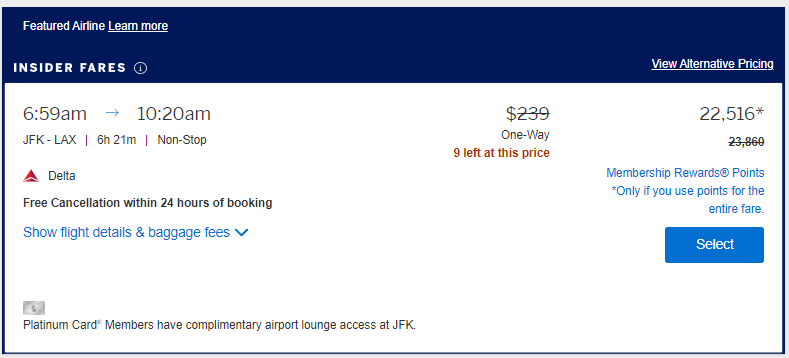
You might have noticed in the example above that the booking is a Membership Rewards Insider Fare .
This can make your bookings through AmexTravel.com even more valuable since American Express sometimes discounts flights if you pay entirely with points .
Consider the flights we discussed above. Booking this itinerary through AmexTravel.com costs 14,636 Membership Rewards points, and the booking still earns Delta SkyMiles as a paid fare rather than an award ticket.
If you were to transfer Membership Rewards to Delta and book this same itinerary as an award ticket, you would have to transfer 25,000 points to your SkyMiles account to book it. In this case, booking through the portal would be a much better deal.
This is clearly a time to book through AmexTravel.com rather than transferring points. To ensure you get the most out of your points every time, it’s important to check both the portal and transfer options when booking economy class.
AmexTravel.com also allows you to book hotels at up to 1 cent per point in value through Fine Hotels & Resorts .
You can also redeem your points for gift cards to merchants like Nike, Saks Fifth Avenue , Walmart, or Amazon , or use your points to shop for items from the Membership Rewards site.
Unfortunately, these are generally terrible uses of your hard-earned Membership Rewards points. To get the most value out of them, stick with travel redemptions!
If you have multiple cards that earn Membership Rewards, they can each be linked to the same account so your points will automatically collect in one place.
Generally, when you apply for a new card that earns Membership Rewards points, it will automatically be linked to your account.
One downside is that points cannot be transferred to your spouse or significant other’s Membership Rewards account.
However, you can transfer points to a frequent flyer program owned by any authorized users on your account, as long as they have been an authorized user for at least 90 days .
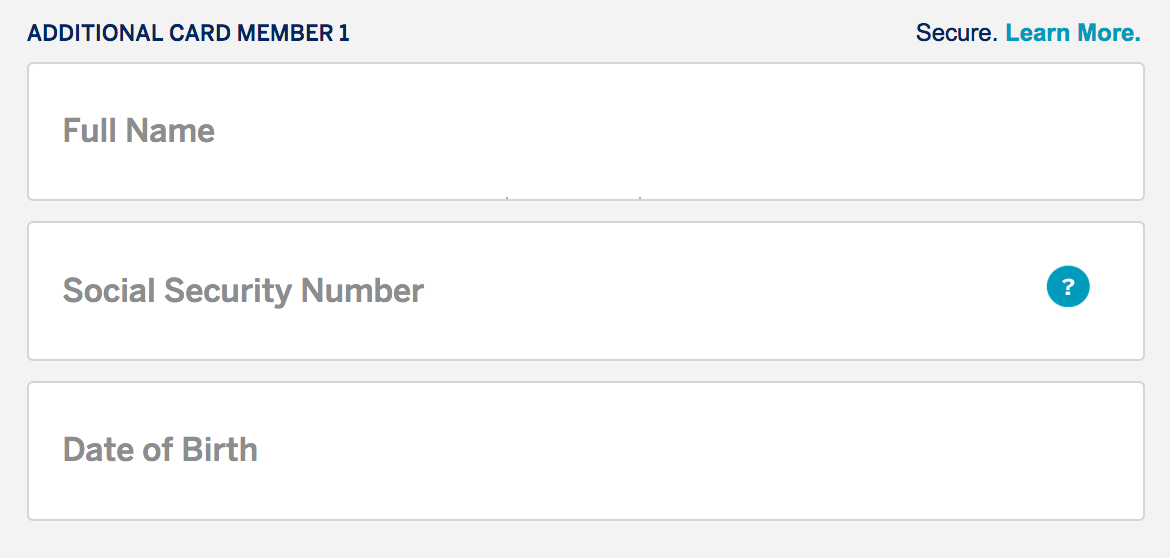
While this isn’t a perfect solution, it still allows you to help friends and family book award flights.
Using your Membership Rewards points for travel is clearly the best way to use your points.
With so many airline transfer partners and tons of ways to redeem your points, it’s almost overwhelming!
To make the process a bit easier, we’ve compiled a list of the best ways to redeem your Membership Rewards for some amazing travel experiences.
American Express Membership Rewards points are tremendously useful if you want to travel. With so many ways to earn and redeem points, you can book award flights to just about anywhere in the world!
For rates and fees of The Platinum Card ® from American Express, click here . For rates and fees of the American Express ® Gold Card, click here . For rates and fees of The Business Platinum Card ® from American Express, click here .
Frequently Asked Questions
What airlines can membership rewards points be used for.
There are multiple different airline and hotel partners that you’re able to transfer your Membership Rewards points to. Refer to our table in the post for the most up-to-date transfer partners!
Can you transfer your Membership Rewards points to another person?
You cannot transfer your Membership Rewards points to anyone else. However, you can transfer your Membership Rewards to someone’s frequent flyer account so long as they are an authorized user on one of your cards and have been so for at least 90 days.
Can you transfer your Membership Rewards between your Amex cards?
American Express pools all of your Membership Rewards points into 1 account, so there is no need to transfer them back and forth between cards.

Can you transfer points from an airline to Membership Rewards points?
You cannot transfer miles or points from an airline to Amex Membership Rewards points. You also cannot get back any Membership Rewards points that you have already transferred to an airline partner — all transfers are final.
Do Membership Rewards points expire?
Your Membership Rewards points will not expire as long as your account remains open and in good standing.
How much are Membership Rewards points worth?
Generally, your Membership Rewards points will be worth 0.6 cents toward cash-back, 1.10 cents when cashing them out into a Charles Schwab investment account (depending on which card you hold), or 2+ cents for redemptions made through transfer partners.
Was this page helpful?
About Jarrod West
Boasting a portfolio of over 20 cards, Jarrod has been an expert in the points and miles space for over 6 years. He earns and redeems over 1 million points per year and his work has been featured in outlets like The New York Times.
INSIDERS ONLY: UP PULSE ™

Get the latest travel tips, crucial news, flight & hotel deal alerts...
Plus — expert strategies to maximize your points & miles by joining our (free) newsletter.
We respect your privacy . This site is protected by reCAPTCHA. Google's privacy policy and terms of service apply.
Related Posts
![points guy amex travel 19 Best Ways To Earn Lots of American Express Membership Rewards Points [2024]](https://upgradedpoints.com/wp-content/uploads/2018/10/Amex-Gold-Upgraded-Points-LLC-12-Large.jpg?auto=webp&disable=upscale&width=1200)
UP's Bonus Valuation
This bonus value is an estimated valuation calculated by UP after analyzing redemption options, transfer partners, award availability and how much UP would pay to buy these points.
- Today's news
- Reviews and deals
- Climate change
- 2024 election
- Fall allergies
- Health news
- Mental health
- Sexual health
- Family health
- So mini ways
- Unapologetically
- Buying guides
Entertainment
- How to Watch
- My Portfolio
- Stock Market
- Biden Economy
- EV Deep Dive
- Stocks: Most Actives
- Stocks: Gainers
- Stocks: Losers
- Trending Tickers
- World Indices
- US Treasury Bonds
- Top Mutual Funds
- Highest Open Interest
- Highest Implied Volatility
- Stock Comparison
- Advanced Charts
- Currency Converter
- Investment Ideas
- Research Reports
- Basic Materials
- Communication Services
- Consumer Cyclical
- Consumer Defensive
- Financial Services
- Industrials
- Real Estate
- Mutual Funds
- Credit Cards
- Balance transfer cards
- Cash-back cards
- Rewards cards
- Travel cards
- Personal Loans
- Student Loans
- Car Insurance
- Morning Brief
- Market Domination
- Market Domination Overtime
- Opening Bid
- Stocks in Translation
- Lead This Way
- Good Buy or Goodbye?
- Fantasy football
- Pro Pick 'Em
- College Pick 'Em
- Fantasy baseball
- Fantasy hockey
- Fantasy basketball
- Download the app
- Daily fantasy
- Scores and schedules
- GameChannel
- World Baseball Classic
- Premier League
- CONCACAF League
- Champions League
- Motorsports
- Horse racing
- Newsletters
New on Yahoo
- Privacy Dashboard
Yahoo Finance
Top travel credit cards, according to the points guy.
When planning ahead for major travel plans , most people turn to their credit card's trusty points systems to find the best deals on bookings and airfare prices.
The Points Guy Director of Content Eric Rosen joins Yahoo Finance for its Travel Guide 2024: Industry Insights special to share advice on how to best utilize credit card perks for travel bookings.
"For now, you have to rack up enough points to actually use those to redeem them for the flights. That said, you can also go for a variety of different credit cards, like a Chase Sapphire Preferred or an Amex Gold Card as part of your wallet, so that you can use actually those points towards the cost of your airfare without having to be loyal to one airline program or another," Rosen says.
Catch more of Yahoo Finance's special Travel Guide 2024: Industry Insights coverage this week, or watch this full episode of Yahoo Finance Live here .
Editor's note: This article was written by Luke Carberry Mogan .
Video Transcript
MADISON MILLS: All right. Well, as folks look to save on their spring and summer vacations, as Carrie mentioned, credit card points can be a smart way to keep your costs down when traveling. So joining us now with the best tips and tricks for putting those points to work as part of our 2024 travel guide, we've got Eric Rosen, The Points Guy's director of content.
Eric, I'm going to jump right in with a personal question from a viewer named my mother. You're booking a flight. You don't have enough points to cover the flight. I told her to wait until she had enough points to buy it. Tell me if I'm right or wrong.
ERIC ROSEN: Well, you're right and wrong, I would say. There are certain airline programs that let you use points towards part of your flight, of course. But for now, you obviously have to rack up enough points to actually use those to redeem them for the flights.
That said, you can also go for a variety of different credit cards, like a Chase Sapphire Preferred or an Amex Gold card, as part of your wallet so that you can actually use those points towards the cost of your airfare, without having to be loyal to one airline program or another. So there are lots of ways to play the game to save some money.
JULIE HYMAN: Well, and also, you just heard our Kerry Hannon talking about the importance of being flexible and booking early, which I suspect is also helpful when you're using points.
ERIC ROSEN: Absolutely. Those are great pieces of advice. Airlines open up their award availability about 331 days in advance. It seems to be typical among US airlines. Some don't schedule quite that far out. So if you know your plans well in advance, that's when you'll find that award availability.
But also, to her point, if you're flexible, you can find some last-minute deals. As airlines find they have unsold seats, they'll open those up for award availability. You can put those miles to use. You might just end up flying, you know, on a Wednesday night instead of a Friday night, things like that. So, the more you can be flexible, the more likely you're going to be able to put your points in miles to use.
MADISON MILLS: And I know part of the advice is to utilize price alerts and to, you know, again, be flexible. To your point, Eric, is there a moment though where you advise people to go ahead and pull the trigger and not continue to hold and wait?
ERIC ROSEN: If you've been tracking prices and they're within your budget, I would say just book the flight then. As you get closer and closer to the departure time, chances are those prices aren't going to drop. You won't see a precipitous $500 to $200 drop on the airfare that you're going for.
So if it fits within your budget, you've got a limited amount of vacation days, the kids are off of school, don't wait too long to book your trip. That said, if things really aren't in your budget, you might want to save it for a later vacation sort of like she had mentioned, where instead of going on your spring break now, think about an early summer trip before everyone's out of school, or towards the end of summer right before school starts again, where you might have a better chance of locking in a good price that fits your budget.
JULIE HYMAN: So, Eric, Maddie asked a question on behalf of her mom. I'm going to ask you a question on behalf of myself. I am not a points girl. And I'm just wondering what-- and I have what is probably a mistaken perception in my mind that it's complicated, right? That navigating, accruing the points, you know, and then using them, that it's somehow difficult to do. Disabuse me of that notion, if it's incorrect. And tell me like, who are these-- who is best served by getting these points situations and cards and using them?
ERIC ROSEN: Absolutely. You know, airline programs, hotel programs do a really good job at making it seem very complicated to use their miles or saying that like, you just need to rack up some miles and you'll get a free flight. And then you go to look and you're not able to find the thing that you actually need. If you want to keep things simple, there are a lot of ways you can do it, right? Get a solid cashback card like the Chase Freedom, right, so you can earn points on every purchase and then use those points for cashback, whether it's on travel expenses or on something else.
We also suggest going for transferable points, something like Chase Ultimate Rewards, Amex Membership Rewards, Capital One miles, where you can redeem them at a set rate for things like flights and hotels so you don't really have to do a ton of mental calculations in order to get some value. Or you can transfer them to a variety of different airline and hotel partners that suit your need at a particular time, rather than having to stick to one program that might change its rules on a dime and leave you without enough miles for that trip you've been having your eye on for the last couple of months.
MADISON MILLS: All right. Eric, one final question here for the users out there who have been utilizing credit card points, I'm wondering about the kind of transfer deals that come up from time to time. What is the best way for folks to stay on top of those potential opportunities, and capitalize on them at the right times?
ERIC ROSEN: Definitely. So when you're talking about are transfer bonuses, where instead of like one Amex point to one British Airways miles or one delta mile, for instance, you might get a 25% bonus. So if you transfer 1,000 of them, you'll get 1,250 miles instead of the usual 1,000. The best way to stay on top of those is to follow sites like ours, The Points Guy, because we have regular updates of what transfer bonuses are currently out there.
And I would say don't go speculatively transferring all of your points from those programs all at once because you should have a specific imminent redemption in mind where you can really take advantage of that extra value, rather than counting on something coming down the pike in a few months time. Because like I said, programs can change, or that hotel that's in one category of award redemption today could go up the next day and then you've transferred all these points and you're not quite able to use them because you can't transfer them back to your other original account.
MADISON MILLS: All right, Eric. We really appreciate it. Thank you so much for that advice and have a great weekend. Thank you.
ERIC ROSEN: Thank you.
Bucket list travel on a budget: Expert tips for airfare, loyalty programs, credit card perks and more
Nicky Kelvin from The Points Guy dives into ways to save this summer.
Many travelers have their sights set on summer getaways , but with everything from baggage fees to fuel costs impacting the price of a ticket, "Good Morning America" is asking travel experts to share tips for booking bucket list destinations on a budget and finding savings along the way.
Travel expert Nicky Kelvin, senior director of content for The Points Guy, offered his tips for affordable travel techniques.

Where to find the best flight deals

Kelvin encourages travelers to utilize Google Flights and other free price-tracking tools to compare fare prices and snag the best deal.
He also suggests using both the calendar and map features within Google Flights to see which airports, dates and destinations how the lowest fare.
From the Google Flights homepage on a computer, click "explore destinations" and select a departure city without adding a destination. Then zoom out on the map to see the best prices for destinations all over the world.
Get the most out of free travel loyalty programs
Travelers should be earning points for anything and everything that they are buying or booking from airline and hotels to car rentals, Kelvin said.
In addition to the points that can can help travelers earn free flights and hotel stays, Kelvin said to look for extra perks just for joining.
Hyatt rewards, for example, offers all guests free breakfast.
For Thrifty Car Rental and Dollar Car Rental, he said you can add your spouse or domestic partner as an additional driver for free.
Loyalty programs are great for airlines too. JetBlue, for example, allows enrolled customers -- even if they don't have enough points for a flight -- to use points for discounts. Plus, with any airline, as you accumulate points to earn status, you can get free seating upgrades.
Travel credit cards with cash back perks
Along with earning points, travel credit cards give you protection for your trip like insurance to help with lost or damaged baggage and trip cancellation protection

Chase debuts new airport lounge: Gourmet menus, sleek interiors, free facials redefine hospitality for airport travel
As for credit cards, The Points Guy team suggests the Capital One Venture Rewards credit card as an all-around pick -- you get 75,000 miles after meeting your minimum spend in the first three months. Which Kelvin said is a value of over $1,300.
If you're looking to earn the most miles, he said look to the Chase Sapphire Preferred Card.
"You'll earn the most points on all your purchases with this one," he said.
Finally, if you want a credit card with no fee, Kelvin suggested the Bilt Mastercard, which he said is particularly great for renters because you can earn points on what's likely someone's biggest expense.
Related Stories

Bengals pick up fifth-year option on receiver Ja'Marr Chase
- Apr 24, 1:49 PM

Shoppers may reduce food waste with GMA challenge
- 3 hours ago

Quesabirria tacos, churros from 'My Mexican Mesa'
Save money on international phone plans for summer trips.
If someone's trip is taking them out of the country, using a cell phone internationally can cost $10 to 15 per day. For a family of four, that's more than $400 for a week.
If your phones support eSIM, Kelvin suggested purchasing a data plan for your destination through an app such as Airalo, Truphone or GigSky.
For example, one of Airalo's global SIM plans costs $9 for one week, which could save a family close to $350 dollars, depending on their existing international coverage.
Related Topics

Time capsule found in school during demolition
- Apr 25, 10:24 PM

What is a tourist tax? Fees for foreign travelers
- Apr 25, 8:06 AM
ABC News Live
24/7 coverage of breaking news and live events
Why I became even more loyal to the Amex Gold during the coronavirus pandemic

Update: Some offers mentioned below are no longer available. View the current offers here .
The ongoing coronavirus pandemic has forced travelers to rethink their credit card rewards strategy from the ground up.
This is especially true for more premium credit cards that have seen their value propositions completely upended. Normally, customers would pay several hundred dollars in upfront annual fees and slowly recoup that value through luxury travel perks, but that system has had to change with people not traveling right now.
Interested in more credit card news and advice from The Points Guy? Sign up for our daily newsletter.
In response to this unprecedented slowdown in travel, issuers have added limited-time perks, statement credits and bonus categories across dozens of cards this year already. The keywords here are limited time . While it's entirely possible that some of these promotions get extended, you shouldn't get used to these new benefits, as most of them will disappear over the coming months.
Related reading: Amex announces limited-time perks for select Amex Membership Rewards, Delta, Marriott and Hilton cards
The American Express® Gold Card is perhaps the most popular card that hasn't had any limited-time COVID-19-related benefits added to it. Still, this pandemic, and the way it's changed people's spending patterns, has helped cement the Amex Gold's spot in my wallet for many years to come.
Read on to see why I love this card so much and will happily be renewing it even without any limited-time perks this year.
Related reading: The Amex Gold will need to offer some temporary perks to convince me to renew
Amex Gold overview

The American Express® Gold Card is relatively unique in an industry with a lot of similar card options. For starters, it straddles the line between premium and entry-level with a $250 annual fee (see rates and fees).
The welcome offer is 60,000 Membership Rewards® points after you spend $4,000 on eligible purchases with your new Card within the first six months of card membership. Select applicants may be targeted for incredible a 75,000-point offer by checking the CardMatch Tool . Note : These offers are subject to change at any time.
The annual statement credit for the card:
- Up to $120 annual dining credit. Earn up to $10 in statement credits monthly when you pay with the Gold Card at participating dining partners (up to $120 total per calendar year), including Grubhub, The Cheesecake Factory, Goldbelly, Wine.com , Milk Bar, and selectShake Shack locations. Enrollment required. This perk is a monthly statement credit similar to the annual Uber credit on The Platinum Card® from American Express, which helps offset its $695 annual fee (see rates and fees). It's easy to enroll through the Amex website to get this Amex Gold benefit. Enrollment required for select benefits.
Another reason the card is such a fan favorite has to do with its foodie-friendly bonus categories. Amex Gold cardholders earn 4x Membership Rewards points per dollar on dining at restaurants and at U.S. supermarkets (U.S. supermarkets capped at $25,000 in purchases per calendar year, then 1x).
The card also earns 3x points per dollar on flights booked directly with the airline or at amextravel.com and 1x everywhere else.
Related Reading: American Express Gold card review
Great for dining and groceries year-round

If you'd asked me at the beginning of 2020, I would have said that travel was one of the most important things in my life. While I'm itching to get back on the road as soon as it's safe to do so, this pandemic has also helped us separate our wants from our needs and reminded us what's truly essential.
There isn't much more essential than food, and that's an area where the Amex Gold leads the pack. Its 4x bonus categories for dining at restaurants and U.S. supermarkets (up to $25,000 per calendar year; then 1x) are among the best out there. And when coupled with the up to $10 monthly dining credit, they help make this card a one-stop-shop for dining out, cooking at home or relaxing on the couch with takeout or delivery. Enrollment required for select benefits.
Related reading: The best credit cards for dining out, taking out and ordering in
At the moment we're seeing many cards offering bonus points on grocery purchases , temporarily displacing the Amex Gold from its spot near the top of the list. It's worth remembering though that many of these bonuses are capped and all of them have expiration dates.
For example, the Chase Sapphire Reserve® -- with its $550 annual fee -- had previously offered 5x points per dollar on your first $1,500 in monthly grocery purchases -- but that ended on June 30, 2020.
However, Chase did add new limited-time perks and bonus categories through Sept. 30, 2020.
- 5x points on Instacart delivery and pickup orders — on up to $3,000 across the three-month promotional period
- Up to $50 in statement credits towards an Instacart Express membership (annual or monthly)
- 5x points at gas stations — on up to $1,500 across the three-month promotional period
- 10x points on select streaming services (such as Spotify or Netflix) — on up to $1,500 across the three-month promotional period
Related reading: The best grocery credit cards for 2020
Once this limited time promotion ends, the Amex Gold will remain a top choice in these popular categories while many of its current competitors go back to earning a measly 1x.
High value with a modest annual fee
While the Amex Gold offers some great bonus categories, it's the high points multiplier that seals the deal. There aren't many cards out there that offer the ability to earn 4x transferable points per dollar or higher in any categories, let alone essential ones such as dining out and groceries.

In fact, only two other transferable points-earning cards come to mind as offering 4x points or higher: The Citi Prestige® Card and The Platinum Card® from American Express. The Citi Prestige, at $495 a year, offers 5x points per dollar in air travel and restaurants. The Amex Platinum earns 5x on airfare booked directly with the airline or Amex Travel (starting Jan. 1, 2021, earn 5x points on up to $500,000 on these purchases per calendar year). Also, earn 5x points on prepaid hotels booked through Amex Travel . The information for the Citi Prestige has been collected independently by The Points Guy. The card details on this page have not been reviewed or provided by the card issuer.
These cards carry annual fees of $495 and $695 respectively, much more than the $250 annual fee (see rates and fees) that the Amex Gold charges. Of course, all three cards offer various statement credits to help offset the annual fee, but you're still looking at twice the upfront cost with those other cards.
Many people simply don't travel enough to justify holding an ultra-premium credit card or aren't interesting in putting in the work necessary to maximize all the benefits to break even on the cost of the higher annual fees. The Amex Gold offers premium earning rates at a much more accessible price point. I'd personally much rather the card keep its 4x earning rate than raise the annual fee in exchange for a higher multiplier.
Bottom line
More often than not you have to pay a premium annual fee in order to unlock valuable bonus categories and benefits. I've always loved that the Amex Gold offers strong earning rates at a very accessible price point.
If anything, the slowdown in travel has only reminded me why I love this card so much. While there are a number of cards temporarily displacing it with limited-time bonus categories , once those promotions expire the Amex Gold will reclaim its spot near the top of my wallet — where I expect it to stay for many years to come.
Apply here for the American Express® Gold Card with a 60,000-point welcome offer.
Check the CardMatch Tool to see if you've been selected for 75,000-point welcome bonus (offers subject to change at any time).
Additional reporting by Chris Dong.
For rates and fees of the Amex Gold Card, please click here. For rates and fees of the Amex Platinum Card, please click here.
Compare Credit Cards
- Best Credit Cards
- Best Travel Credit Cards
- Best Cash Back Credit Cards
- Easiest Credit Cards to Get
- Best Grocery Credit Cards
- American Express Platinum Review
- Capital One Venture X Review
- Chase Sapphire Reserve Review
- Amex Gold vs. Platinum 2024: Which Is Best for You?
- Chase Sapphire Preferred vs. Amex Platinum 2024: Which Is Best for You?
- First Credit Card Guide
- Guide to Credit Score Ranges
- What Is a Good APR for a Credit Card?
- How Many Credit Cards Should I Have?
- How To Choose A Credit Card
Savings Accounts
- Best High-Yield Savings Accounts
- 7% Interest Savings Account Rates
- Best Health Savings Accounts
- Current Savings Account Rates
- All Savings Articles
Checking Accounts
- Best High-Yield Checking Accounts
- Best Business Checking Accounts
- Best No-Fee Checking Accounts
- How To Write a Check
- All Checking Articles
- Best CD Rates
- Best Jumbo CD Rates
- Best IRA CD Rates
- Current CD Rates
- All CD Articles
- Best Online Banks
- Best Bank Account Bonuses
- Average Money Market Account Rates
- Capital One Bank Review
- All Banking Articles
Personal Loans
- Best Personal Loans
- Easiest Personal Loans to Get
- Best Debt Consolidation Loans for Bad Credit
- Tax Refund Loans
- All Personal Loans Articles
Student Loans
- Best Student Loan Rates
- Best International Student Loans
- Best Private Student Loans
- Best Refinance Student Loans
- All Student Loans Articles
Business Loans
- Best Online Business Loans
- Best Startup Business Loans
- Best Business Loans for Veterans
- Best Business Lines of Credit
- All Business Loans Articles
- Best Antivirus Software
- Best Free Antivirus Software
- Fastest VPNs
Website Builders
- Best Website Builders
- Best Free Blog Sites
- Best Web Design Services
- Best Cloud Hosting Services
- Best LLC Services
- Best States to Form an LLC
- How To Set Up an LLC
- How Much Does It Cost To Start an LLC?
Compare Investments
- Best Stocks
- Best Investment Apps
- Best Dividend Stocks
- Best Cryptocurrency
Learn About Investments
- How To Invest $1000: 7 Steps to Grow Your Money
- Roth IRA Contribution Limits
- 401(k) Contribution Limits
- Stock Market Basics
- Investment Strategies For Beginners
- Best Mortgage Lenders
- What is a Mortgage?
- How to Get a Mortgage
- First-Time Homebuyers Guide
- All Mortgage Articles
Home Services
- Best Home Warranty Companies
- Best Home Security Systems
- Best Internet Providers
- Best Internet Speed Tests
- All Home Services Articles
- Best Tax Software
- Best Tax Software for Small Businesses
- Best Free Tax Software
- When Is The Last Day To File Taxes?
- All Taxes Articles
- Best Auto Loan Refinance Lenders
- Best Car Warranty Companies
- Best Used Car Warranty Companies
- Best Extended Car Warranties
- All Auto Articles
Credit Cards
Small Business
MORE FROM VAULT
Wells Fargo Autograph Journey Credit Card Review 2024: Earn up to 5X Points on Travel Purchases

Lee Huffman
Credit Cards Expert
Lee Huffman spent 18 years as a financial planner and corporate finance manager before quitting his corporate job to write full-time in 2018. He has been writing about early retirement, credit cards, travel, insurance and other personal finance topics since 2012. Lee enjoys showing people how to travel more, spend less and live better by taking control of their finances. When Lee is not getting his passport stamped around the world, he’s researching methods to earn more miles and points toward his next vacation.
His writing can be found on many popular travel and personal finance websites such as The Points Guy, U.S. News, Forbes and NerdWallet. You can follow Lee’s travels at BaldThoughts.com or listen to his weekly travel podcast at WeTravelThere.com.

Claire Dickey
Senior Editor
Claire is a senior editor at Newsweek focused on credit cards, loans and banking. Her top priority is providing unbiased, in-depth personal finance content to ensure readers are well-equipped with knowledge when making financial decisions.
Prior to Newsweek, Claire spent five years at Bankrate as a lead credit cards editor. You can find her jogging through Austin, TX, or playing tourist in her free time.
Updated April 24, 2024 at 2:14 pm
Understanding the value of cash back is simple, but valuing airline miles or points redeemable for travel requires digging a bit deeper. At Newsweek, we’ve developed a common language to talk about the value of points and miles: our valuations.
Our valuations translate points into dollars and cents in a way that reflects reality. They are based on actual data across a balance of accessible redemption options, not just the aspirational first and business class redemptions that require a PhD in miles and points to book. The upshot is that our valuations help you understand the actual value you can easily get from your miles and points.

Wells Fargo Autograph Journey℠ Card
Wells Fargo’s new travel rewards card earns up to 5X points on travel-related purchases.
Expert Take : The Wells Fargo Autograph Journey℠ Visa® Card is an excellent choice for travelers who want to maximize rewards on travel purchases booked directly with airlines, hotels and other providers. While it has an annual fee, the $50 annual flight credit covers more than half of the cost. It also includes complimentary travel protections and cell phone insurance to cover unexpected situations.
- Earns up to 5X points on travel-related purchases
- $50 annual flight credit with a minimum $50 airline purchase
- Flexible rewards redemptions include transfers to airline and hotel partners
- Missing bonus categories on everyday purchases, like gas and groceries
- Does not include an intro APR offer on purchases or balance transfers
- Current list of transfer partners is smaller than competitors
Vault’s Viewpoint on Wells Fargo’s Autograph Journey Card
As competitors like Chase, Amex and Capital One gained legions of loyal followers, Wells Fargo missed out on the growth because of its meager credit card lineup. With the introduction of the Autograph Journey credit card and transferable points, Wells Fargo is taking a huge step forward.
The Wells Fargo Autograph Journey Card is designed with travelers in mind by earning 5X points on hotels, 4X points on airlines and 3X points on dining and all other travel purchases. With the introduction of transferable points, cardholders can redeem for cash back, travel, gift cards and more or transfer points to a growing list of Wells Fargo airline and hotel partners. Plus, it includes a $50 annual statement credit toward airline purchases. Travelers are also covered with an array of travel protections and cell phone insurance in case something goes wrong.
About the Wells Fargo Autograph Journey Travel Credit Card
The Wells Fargo Autograph Journey credit card builds upon the success of the original Wells Fargo Autograph℠ Card , as it also earns flexible points but with a focus on travel and dining purchases.
With the Autograph Journey, you’ll earn up to 5X points on travel-related purchases and an unlimited 3X points on dining worldwide. The card includes an annual flight credit that’s good on any airline, without having to choose an airline ahead of time. When you book trips with the Autograph Journey Card, you’ll receive valuable travel benefits to protect your trip, like rental car protection, trip cancellation/interruption protection, lost baggage reimbursement and more. Your cell phone is also covered up to $1,000, up to two times per 12-month period, when you pay the bill with your Autograph Journey Card (subject to a $25 deductible).
As a new cardholder, you can earn 60,000 bonus points by spending at least $4,000 on purchases within the first three months. These points are worth $600 toward travel and have numerous redemption options, including booking flights and hotels, getting cash back or buying gift cards. Wells Fargo also introduced transfer partners in April 2024, so you can transfer points to airlines and hotels to book award reservations worth potentially even more.
Benefits of the Wells Fargo Autograph Journey Card
In this Wells Fargo Autograph Journey Card review, you’ll learn about the card’s numerous benefits and how they can improve your travel experience.
Earning Power
People who love to travel can maximize their rewards with the Autograph Journey Card. This card’s bonus categories target the areas where travelers spend the most—flights, hotels, dining and other travel purchases.
Flexible Redemptions and Transfer Partners
The points earned from the Autograph Journey credit card have multiple redemption options. You can redeem them as a credit to your Wells Fargo credit card statement, as a deposit to your Wells Fargo bank account or to reduce your Wells Fargo mortgage balance. Points can be used to pay for online shopping or to buy gift cards. You can also book travel through Wells Fargo.
As of April 2024, Wells Fargo introduced hotel and airline transfer partners. The initial partners include:
- Choice Privileges®
- Air France-KLM Flying Blue
- Avianca LifeMiles
- British Airways Executive Club
- Aer Lingus AerClub
- Iberia Plus
Wells Fargo plans to expand this lineup to offer even more transfer opportunities to cardholders.
$50 Annual Airline Credit
Each year, you’ll receive a statement credit of $50 when you make an airline purchase of $50 or more. Unlike some airline credits, these can be used to buy airfare as well—and you don’t have to choose an airline ahead of time. Qualifying purchases include airfare, upgrades, checked baggage, change fees and more. So, whether you’re booking a flight or paying for a fee related to a flight you’re taking, this annual airline credit has your back.
Travel Protections
The best-laid travel plans can easily go astray when your flight is canceled, your bag is lost or something happens to your rental car. Your trip is covered when you use the Wells Fargo Autograph Journey Visa to book your reservations. Trip cancellation and interruption protection covers you up to $15,000 for lodging, flights and activities when your trip is canceled or interrupted for a covered reason.
If your checked or carry-on luggage is lost or stolen during transit, you’re covered for up to $3,000 per trip. Additionally, your rental car is protected against damage or theft with secondary rental car insurance. The card also comes with up to $1,000,000 in travel accident insurance, travel and emergency services assistance, roadside dispatch and more.
Cell phone Insurance
When you pay your cell phone bill with the Autograph Journey Card, you’re covered for up to $1,000 in cell phone insurance (up to two claims per 12-month period). This coverage protects you against damage, theft or loss, and it requires a simple $25 deductible.
Visa Signature Luxury Hotel Collection
As a Visa Signature credit card, this Wells Fargo credit card includes access to the Visa Signature Luxury Hotel Collection. Book a stay at one of the participating hotels to receive benefits similar to those who have elite status. Benefits include the best available rate guarantee, complimentary room upgrade (when available), complimentary breakfast for two, VIP guest status, late checkout upon request (when available) and a $25 food and beverage credit. Select hotels offer additional perks like a free hotel night, resort credits and more.
Autograph Card Exclusives
Eligible Wells Fargo cardholders also have access to Autograph Card Exclusives. These live, intimate events feature a limited number of tickets available exclusively to cardholders to purchase. Events occur throughout the U.S., and available artists and experiences change during the year.
Who Is the Wells Fargo Autograph Journey Card Best For?
The Autograph Journey from Wells Fargo is best for travelers who want to maximize rewards on travel purchases. This card’s bonus categories center around travel and dining, and it doesn’t require cardholders to book through the bank’s travel portal to earn maximum rewards. This card allows you to book directly with airlines, hotels and other travel providers to earn credit card rewards and perks from the loyalty programs.
While the card has a $95 annual fee, it is offset by its yearly $50 credit toward airline purchases. Simply book flights of $50 or more to automatically receive the statement credit on your next bill. The card’s complimentary travel protections and cell phone insurance also provide peace of mind for frequent travelers and people whose cell phone is an indispensable part of their daily lives.
Travelers who want to earn flexible rewards points that can transfer to airline and hotel loyalty programs will also be excited about this new Wells Fargo credit card . The Autograph Journey launches with five airline partners and one hotel partner. While this total is smaller than competing brands, Wells Fargo is working to expand its list of transfer partners, and more brands will be added throughout the year.
Who Should Consider an Alternative to the Wells Fargo Autograph Journey Card?
While the Wells Fargo Autograph Journey has much to offer, it may not be the right card for every traveler. Wells Fargo intends to add more transfer partners over time, but some consumers may not want to wait that long or roll the dice that new partners will be among their preferred brands. Consumers who want access to a greater array of transfer partners should look at alternatives from Chase , Citi, Capital One or American Express , since each of those programs has 14 or more partners to choose from.
Having access to TSA PreCheck or Global Entry while traveling is a huge timesaver. The Autograph Journey credit card does not offer reimbursement for these Trusted Traveler application fees. Some travel credit cards at the same price point, like the Capital One Venture Rewards Credit Card or the United℠ Explorer Card (whose benefit also applies to the NEXUS program), include reimbursement once every four years.
How Does the Wells Fargo Autograph Journey Card Stack Up to Its Competitors?
Before applying for the Wells Fargo Autograph Journey Card, compare it to these popular travel credit cards to decide which one is best for your wallet.
Wells Fargo Autograph Journey vs Chase Sapphire Preferred® Card
The Chase Sapphire Preferred is a solid travel credit card that earns Ultimate Rewards points. With this card, you’ll earn 5X points on travel when booking through Chase Travel and 2X points on other travel purchases, such as when purchasing directly with the airline, hotel or other provider. The Autograph Journey doesn’t require you to book through its portal to earn its top rewards rates and earns 50% more points on all other travel purchases. The Sapphire Preferred also earns 3X points on dining, select streaming services and on online groceries (excluding Target, Walmart and wholesale clubs), while the Autograph Journey earns 3X points only on dining.
When you redeem Ultimate Rewards points, you’ll get 25% more value when booking travel through Chase Travel. This extra value means you’ll redeem fewer points than booking similar travel through Wells Fargo. There are also 14 Chase airline and hotel partners , which is nearly three times as many options, and it features well-known domestic brands like United, Southwest, Hyatt and Marriott.
Wells Fargo Autograph Journey vs. Capital One Venture Rewards Credit Card
With the Capital One Venture Rewards Card , you’ll earn an unlimited 2X miles on every purchase and 5X miles on hotels and car rentals booked through Capital One Travel. While it doesn’t offer the same earning power as the Autograph Journey, the Venture Card offers a solid rewards rate on every purchase, which is ideal for people who don’t want to remember which categories offer extra rewards. The card also includes up to $100 reimbursement for Global Entry or TSA PreCheck membership application fees and complimentary Hertz Five Star elite status, which the Autograph Journey cannot match.
Capital One miles can be redeemed for cash back, travel, gift cards and more. Cardholders can also get statement credits for purchases made in the previous 90 days. Further, Capital One offers more than 15 airline and hotel transfer partners, which is three times as many options as Wells Fargo. The card does not charge foreign transaction fees, and it includes auto rental collision damage waiver and extended warranty protection on eligible purchases made with your card.
Wells Fargo Autograph Journey vs. Wells Fargo Autograph℠ Card
For people who want to earn Wells Fargo credit card points but don’t want to pay an annual fee, the Wells Fargo Autograph Card is a solid choice. This card earns an unlimited 3X points on travel, gas, restaurants, transit, popular streaming services and phone plans. These bonus categories are an excellent way to maximize common spending categories, and many of these household categories aren’t available from the Autograph Journey Card.
Additionally, the no-annual-fee Autograph card includes an introductory APR offer on purchases, which the Autograph Journey doesn’t offer. If you need extra time to pay off your purchases without incurring interest charges, the Wells Fargo Autograph Card is the best option. This card includes many of the same protections as the $95 annual fee Autograph Journey, and its points also can be redeemed for cash back, gift cards and more or transferred to airline and hotel partners.
Frequently Asked Questions
What credit score do you need for a wells fargo autograph journey card.
For the best approval odds, you should have good to excellent credit when applying for the Autograph Journey Card. A good FICO credit score ranges from 670 to 739, while very good to exceptional FICO credit score start at 740 and above. If your credit score is below these levels, take steps to improve your score before applying.
How Much Are 60,000 Wells Fargo Points Worth?
At the most basic level, Wells Fargo points are worth 1 cent each toward travel, cash back, gift cards and more. This means that the 60,000 welcome bonus points from the Wells Fargo Autograph Journey Card are worth $600. With the introduction of transfer partners, you may receive even higher value when transferring points to book award flights or hotel rooms.
Does the Wells Fargo Autograph Journey Card Have Lounge Access?
No, the Autograph Journey does not include lounge access. To receive airport lounge access, typically, you’ll need to get a premium credit card for travel with an annual fee that likely ranges $395 or higher. Premium travel credit cards are best for frequent travelers who can justify paying such a high annual fee.
Related Articles

Editorial Note: Opinions expressed here are author’s alone, not those of any bank, credit card issuer, hotel, airline or other entity. This content has not been reviewed, approved or otherwise endorsed by any of the entities included within the post. We may earn a commission from partner links on Newsweek, but commissions do not affect our editors’ opinions or evaluations.

The best credit cards for booking cruises
Editor's note: This is a recurring post, regularly updated with new information and offers.
There is one common question we get from TPG readers who are cruise enthusiasts: What are the best credit cards for booking cruises?
It might seem logical that the best way to earn rewards on cruise bookings is to get a cruise line cobranded credit card . However, these generally don't offer as solid of a value as the best travel credit cards .
For example, the Royal Caribbean® Visa Signature® Card currently offers a sign-up bonus of 25,000 bonus points (worth $250 in onboard credit) after you spend $1,000 within 90 days of account opening and an ongoing rate of 2 points per dollar on Royal Caribbean and Celebrity Cruises purchases. This might seem like a good bonus, but you can actually get a much better value from the welcome bonus on most general travel credit cards.
The information for the Royal Caribbean Visa Signature Card has been collected independently by The Points Guy. The card details on this page have not been reviewed or provided by the card issuer.
If you want to get the most value from your vacation purchases, here we explore the best credit cards for booking cruises and why you always want to pay for your vacation at sea with a credit card.
For cruise news, reviews and tips, sign up for TPG's cruise newsletter .
Why use a credit card to book your cruise?
At TPG, we recommend using a credit card whenever and wherever possible so you always earn rewards on your purchases. When it comes to cruises, you'll get some serious benefits by booking with a credit card.
Earn points and miles
A cruise is a significant expense, which means it's an opportunity to earn significant rewards. You can use a cruise booking to help you hit a spending requirement and earn a valuable welcome bonus on a new card or earn rewards to put toward future travel by using a card that earns bonus points on travel purchases .
Protect from billing mistakes
We've all experienced billing mistakes and the headaches that come with them. If you use cash or a debit card for your cruise, a billing mistake can mean money is already gone from your account before you realize there's an issue. By using a credit card, your money is safe while you work to get the issue resolved .
Protect your spending
Many travel rewards cards come with trip delay and cancellation insurance , so you'll be protected if your travel plans go awry. If you plan on doing significant shopping while on your ship, you can use a card with purchase protection to ensure your item arrives safely home.
Related: Everything you need to know about cruise insurance
When deciding which credit card to use for booking cruises, you'll want to consider the rewards a card earns on cruises and benefits like travel and shopping protections. You can also benefit from a card's more specific perks, like statement credits for travel and airport lounge access.
With this in mind, we recommend these credit cards for booking a cruise:
The information for the American Express Green Card and U.S. Bank Altitude Reserve Visa Infinite Card has been collected independently by The Points Guy. The card details on this page have not been reviewed or provided by the card issuer.
American Express Green Card
Welcome bonus: Earn 40,000 Membership Rewards points after spending $3,000 in your first six months of card membership, worth $800 according to TPG valuations .
Annual fee: $150
Why it's great for booking cruises: The Amex Green earns 3 points per dollar on travel purchases , including cruises. This means you'll earn bonus points on the cruise booking as well as any airfare or hotel purchases you make to get to and from your cruise. You'll also get trip delay insurance * that covers you up to $300 per trip (maximum of two claims per 12-month period) and purchase protection † for up to 90 days after you make a purchase.
*Eligibility and benefit level varies by card. Terms, conditions and limitations apply. Visit americanexpress.com/benefitsguide for details. Policies are underwritten by New Hampshire Insurance Company, an AIG Company.
†Eligibility and benefit levels vary by card. Terms, conditions and limitations apply. Visit americanexpress.com/benefitsguide for details. Policies are underwritten by AMEX Assurance Company.
The information for the American Express Green Card has been collected independently by The Points Guy. The card details on this page have not been reviewed or provided by the card issuer.
For more details, please see our full review of the Amex Green .
Related: Who should (and shouldn't) get the Amex Green?
Bank of America Premium Rewards credit card
Welcome bonus: Earn 60,000 bonus points after spending $4,000 in the first 90 days of account opening, worth $600.
Annual fee: $95
Why it's great for booking cruises: The Bank of America Premium Rewards credit card earns 2 points per dollar on all travel purchases, including cruise line purchases as well as hotel and airline purchases. You'll also get travel protections such as trip delay/cancellation/interruption insurance and purchase protection for up to 90 days after your date of purchase.
And if you're a Bank of America Preferred Rewards® member, you'll earn an additional 25%-75% rewards bonus on every purchase — giving you an even greater return on your cruise spending.
For more details, please see our full review of the Bank of America Premium Rewards credit card .
Apply here: Bank of America Premium Rewards credit card
Related: Everything you should know about Bank of America's Preferred Rewards program
Capital One Venture Rewards Credit Card
Welcome bonus: Earn 75,000 Capital One miles after spending $4,000 in the first three months from account opening, worth $1,388 according to TPG valuations .
Annual fee: $95 (see rates and fees )
Why it's great for booking cruises: The Capital One Venture Rewards earns 2 miles per dollar on all purchases, including cruise bookings. You can redeem the rewards you earn for a statement credit to cover travel expenses, including cruise line purchases. You'll also get travel and emergency assistance services.
For more details, please see our full review of the Capital One Venture Rewards .
Apply here: Capital One Venture Rewards
Related: 7 reasons to get the Capital One Venture Rewards card
Capital One Venture X Rewards Credit Card
Annual fee: $395 (see rates and fees )
Why it's great for booking cruises: Like the Venture Rewards, the Venture X earns 2 miles per dollar on all purchases, including cruises, and comes with several travel protections. What makes the Venture X stand out is that it can make your trip run more smoothly with additional perks like complimentary airport lounge access, a statement credit for TSA PreCheck or Global Entry and a $300 annual credit for travel booked through Capital One Travel.
For more details, please see our full review of the Capital One Venture X .
Apply here: Capital One Venture X
Related: Is the Venture X worth the annual fee?
Chase Sapphire Preferred
Welcome bonus: Earn 60,000 Chase Ultimate Rewards points after spending $4,000 on purchases in the first three months from account opening, worth $1,230 according to TPG valuations .
Why it's great for booking cruises: The Chase Sapphire Preferred earns a valuable 2 points per dollar on travel purchases , including cruise bookings. What makes this card stand out is its impressive travel protections . When you use it to book travel, you'll get protection against lost or delayed baggage, as well as trip delays, accidents and cancellations.
For more details, please see our full review of the Chase Sapphire Preferred .
Apply here: Chase Sapphire Preferred
Related: Why the Chase Sapphire Preferred is perfect for the average traveler
Chase Sapphire Reserve
Annual fee: $550
Why it's great for booking cruises: The Chase Sapphire Reserve earns 3 points per dollar on travel purchases, including cruise bookings. You'll also get a slightly better suite of travel protections than with the Sapphire Preferred, plus airport lounge access and a credit for TSA PreCheck or Global Entry. Perhaps the best perk on this card, however, is a $300 annual travel statement credit automatically applied to travel purchases, meaning you can get $300 back on your cruise booking when you use this card to pay.
For more details, please see our full review of the Chase Sapphire Reserve .
Apply here: Chase Sapphire Reserve
Related: Chase Sapphire Preferred vs. Sapphire Reserve
The Platinum Card from American Express
Welcome bonus: Earn 80,000 Membership Rewards points after spending $8,000 in the first six months of card membership, worth $1,600 according to TPG valuations .
Annual fee: $695
Why it's great for booking cruises: You won't earn bonus points on cruise bookings with this card, but you'll get access to the Amex Cruise Privileges Program , where you'll receive onboard credit and an extra onboard amenity for each cruise booking. Plus, the Amex Platinum earns 5 points per dollar on flights (when booking with the airline or through Amex Travel on up to $500,000 on these purchases per calendar year) and comes with comprehensive airport lounge access , so it's also great for booking travel to and from your cruise departure port.
For more details, please see our full review of the Amex Platinum .
Apply here: Amex Platinum
Related: How to maximize benefits with the Amex Platinum
U.S. Bank Altitude Reserve Visa Infinite Card
Welcome bonus: Earn 50,000 bonus points after spending $4,500 in the first 90 days of account opening, worth $750.
Annual fee: $400.
Why it's great for booking cruises: The Altitude Reserve earns 3 points per dollar on travel purchases and comes with up to $325 in annual credits for travel purchases. This means you can get $325 back on your cruise booking when you use this card.
For more details, please see our full review of the Altitude Reserve .
Related: Best credit cards with annual travel statement credits
Bottom line
Using the right credit card to book your cruise allows you to rack up some serious rewards on your booking and protect yourself against a wide range of mishaps. Whether you're focused on hitting a valuable sign-up bonus to help fund your next trip or earning bonus points on your onboard cocktails, you can feel great knowing your card is working hard while you're kicking back at sea.
For Capital One products listed on this page, some of the above benefits are provided by Visa® or Mastercard® and may vary by product. See the respective Guide to Benefits for details, as terms and exclusions apply.
Planning a cruise? Start with these stories:
- The 5 most desirable cabin locations on any cruise ship
- A beginners guide to picking a cruise line
- The 8 worst cabin locations on any cruise ship
- The ultimate guide to what to pack for a cruise
- A quick guide to the most popular cruise lines
- 21 tips and tricks that will make your cruise go smoothly
- 15 ways cruisers waste money
- The ultimate guide to choosing a cruise ship cabin
For rates and fees of the American Express Green Card please click here .
For rates and fees of the Platinum Card from American Express please click here .
Editorial disclaimer: Opinions expressed here are the author’s alone, not those of any bank, credit card issuer, airline or hotel chain, and have not been reviewed, approved or otherwise endorsed by any of these entities.


IMAGES
COMMENTS
The American Express Travel portal allows you to redeem Membership Rewards points directly for travel reservations and activities rather than transfer your rewards to airline or hotel partners like Delta Air Lines SkyMiles and Marriott Bonvoy.. You also can book discounted premium tickets, use benefits like a 35% points rebate on certain bookings and even book premium hotels with additional ...
Brian Kelly, the founder of a website called The Points Guy, had both — plus a few million unused frequent-flier miles. This was how, on Saturday, Aug. 7, he found himself heading from New York ...
1. Login and input travel details. To use your Membership Rewards points to Pay With Points, start by logging into your AmEx account at American Express Travel. Choose the type of travel you want ...
Eligible Card Members can redeem Membership Rewards® points for travel in a variety of ways: Book your next travel adventure through American Express Travel® at amextravel.com. You can use points to cover all or part of your trip.*. Transfer points to participating frequent flyer and hotel loyalty programs. Treat yourself or someone special ...
Amex Platinum vs. Chase Sapphire Reserve®. With a $550 annual fee, similar lounge perks and a hefty welcome bonus (Earn 60,000 bonus points after you spend $4,000 on purchases in the first 3 months from account opening. That's $900 toward travel when you redeem through Chase Travel℠), the Chase Sapphire Reserve is a worthy contender.
American Express Membership Points are worth 1 cent each on FHR & flights booked in the portal. Other in-portal direct redemptions are worth 0.7 cents. The current AmEx points value is 2.8 cents ...
MSN has partnered with The Points Guy for our coverage of credit card products. MSN and The Points Guy may receive a commission from card issuers. Editor's note: This is a recurring post ...
Search. Step 1. Log in to AmexTravel.com to access Membership Rewards points and begin by searching for a trip as usual. Apply Points. Step 2. At checkout, select either "Use Only Points" or "Use Points + Card" then apply points to your booking. Book Trip. Step 3. Once booked, your Card will be charged the full dollar amount.
Chris was a reporter at The Points Guy, where he covered the intersection of credit card rewards and travel. At TPG, he wrote a broad array of stories ranging from in-depth features and reports to trending travel news as it related to loyalty, card benefits and consumer behavior. ... (Photo by Ryan Patterson/The Points Guy) The Amex Platinum ...
Step 2: Select Transfer Points under Redeem. Image Credit: American Express. Step 3: Choose your desired airline or hotel transfer partner and select Transfer Points. If you haven't already, you will need to link your frequent flyer account to your Membership Rewards account.
When planning ahead for major travel plans, most people turn to their credit card's trusty points systems to find the best deals on bookings and airfare prices. The Points Guy Director of Content ...
The biggest benefit of a travel credit card is the flexibility you get when redeeming your points or miles. Unlike an airline credit card, travel credit cards have a variety of transfer partners ...
As for credit cards, The Points Guy team suggests the Capital One Venture Rewards credit card as an all-around pick -- you get 75,000 miles after meeting your minimum spend in the first three months.
The Chase Sapphire Reserve is one of our top premium travel cards. With a $300 travel credit, bonus points on dining and travel purchases and other benefits, you can get excellent value that far exceeds the annual fee on the card. Read our full review of the Chase Sapphire Reserve card. VIEW MORE.
If you have American Express, Capital One, Chase or Citi points, you might be able to get a redemption value of 1 to 1.5 cents per point for cruises. In this case, you'd get $100 or $150 off your ...
Must first add offer to Card and then use same Card to redeem. Only U.S.-issued American Express® Cards are eligible. Limit 1 enrolled Card per Card Member across all American Express offer channels. Your enrollment of an eligible American Express Card for this offer extends only to that Card. Valid online only. Valid only on U.S. website.
You can then link each transfer partner in your Membership Rewards account and transfer Membership Rewards points in increments of 1,000 to any partner you wish, with a minimum of 1,000 points. American Express offers bonuses to transfer to select partners from time to time. Transfers to travel partners are non-reversible, so make sure you are ...
Rewards: Earn 1 point per dollar on rent payments without the transaction fee (on up to 100,000 points each calendar year), 3 points per dollar on dining, 2 points per dollar on travel (when ...
The Citi Prestige, at $495 a year, offers 5x points per dollar in air travel and restaurants. The Amex Platinum earns 5x on airfare booked directly with the airline or Amex Travel (starting Jan. 1, 2021, earn 5x points on up to $500,000 on these purchases per calendar year). Also, earn 5x points on prepaid hotels booked through Amex Travel. The ...
Welcome to The Points Guy, your go-to source for all things travel, points, miles, credit cards and more. ... The simplest option is to use the points to book travel via the credit card's travel ...
Maximize points on every purchase. Track all your points, miles and rewards in one place. Find limited-time offers for new credit cards. Identify earning gaps and round out your wallet. Scan the QR code using the Camera app on your iPhone®. Maximize your travel with hands-on travel advice, guides, reviews, deal alerts, and more from The Points ...
For people who want to earn Wells Fargo credit card points but don't want to pay an annual fee, the Wells Fargo Autograph Card is a solid choice. This card earns an unlimited 3X points on travel ...
Plus, the Amex Platinum earns 5 points per dollar on flights (when booking with the airline or through Amex Travel on up to $500,000 on these purchases per calendar year) and comes with ...
The information for the American Express Green Card has been collected independently by The Points Guy. The card details on this page have not been reviewed or provided by the card issuer. Bilt Rewards. Bilt offers one credit card, the Bilt Mastercard® (see rates and fees). Cardmembers earn 1 Bilt Point per dollar spent on rent (on up to ...